THE HMR OPPORTUNITY Inside Metro’s Private-Label Success
SECURING THE GROCERY AISLES GET READY FOR COLD & FLU SEASON!

THE HMR OPPORTUNITY Inside Metro’s Private-Label Success
SECURING THE GROCERY AISLES GET READY FOR COLD & FLU SEASON!


Vancouver Convention Centre
West Building | Vancouver, BC
Conference: February 20, 2026
Trade Show: February 21–22, 2026

Trade Show Hours: 10:00 AM – 5:00 PM PT
















membership is not required to attend. Online registration for the trade show is free for retailers and CHFA members only. Advanced online registration ends on January 29, 2026 for non-CHFA Members. On-site registration for the trade show and conference is available. Trade show fees apply for non-member health practitioners, brands and business services. Conference fees apply for all non-members.
ID and proof of industry involvement is required. Restrictions apply. Visit chfanow.ca/vancouver for full attendee policy.









































































COLUMNS
12 Secret sauce
How a Toronto trio turned a lockdown idea into a thriving sauce and condiment business IDEAS
15 Measuring the tariff effect NIQ Canada study gauges consumer sentiment around economic pressures
17 Preparing for the unexpected? Most small business owners have insurance, but many don’t use it when it matters most
19 Overcoming self-doubt
Star Women in Grocery winners, past and present, on building inner confidence
23 Peak retail season brings early, smart shoppers Caddle research reveals the behaviours that will drive sales this holiday season
25 Retail power shifts in Canada How Canadians shop is evolving, Kantar’s Amar Singh explains why
FRESH
45 Consumers crave more from HMR Quality and value are on order when it comes to ready-made meals
AISLES
49 Choc-full of potential From premium to purposedriven products, here’s what’s fuelling the chocolate category
52 Cold comforts The health and wellness wave hits the medicine cabinet

20 Stars in our eyes
See photos from this year’s sold-out Star Women in Grocery Awards ceremony!

55 Alternative pastas: Four things to know Hearty, healthy and anything but ordinary EXPRESS LANE

56 Food for thought Food economist Michael von Massow unpacks food inflation, shopper habits and more


2300 Yonge Street, Suite 2900, Toronto, ON M4P 1E4
(877) 687-7321 Fax (888) 889-9522
www.canadiangrocer.com
BRAND MANAGEMENT
GROUP PUBLISHER/SVP,
GROCERY & CONVENIENCE, CANADA Sandra Parente (416) 271-4706 - sparente@ensembleiq.com
PUBLISHER Vanessa Peters vpeters@ensembleiq.com
EDITORIAL
EDITOR-IN-CHIEF Shellee Fitzgerald sfitzgerald@ensembleiq.com
MANAGING EDITOR Kristin Laird klaird@ensembleiq.com
DIGITAL EDITOR Kaitlin Secord ksecord@ensembleiq.com
ADVERTISING SALES & BUSINESS
NATIONAL ACCOUNT MANAGER Karishma Rajani (on leave) (437) 225-1385 - krajani@ensembleiq.com
NATIONAL ACCOUNT MANAGER Julia Sokolova (647) 407-8236 - jsokolova@ensembleiq.com
NATIONAL ACCOUNT MANAGER Roberta Thomson (416) 843-5534 - rthomson@ensembleiq.com
ACCOUNT MANAGER Juan Chacon jchacon@ensembleiq.com
DESIGN/PRODUCTION/MARKETING
CREATIVE DIRECTOR Nancy Peterman npeterman@ensembleiq.com
ART DIRECTOR Jackie Shipley jshipley@ensembleiq.com
SENIOR PRODUCTION DIRECTOR Michael Kimpton mkimpton@ensembleiq.com
MARKETING MANAGER Jakob Wodnicki jwodnicki@ensembleiq.com
EDITORIAL ADVISORY BOARD
RAY HEPWORTH , METRO
BRENDA KIRK , PATTISON FOOD GROUP
CHRISTY MCMULLEN , SUMMERHILL MARKET
GIANCARLO TRIMARCHI VINCE’S MARKET
SUBSCRIPTION SERVICES
Subscriptions: $102.00 per year, 2 year $163.20, Outside Canada $163.20 per year, 2 year $259.20 Single Copy $14.40, Groups $73.20, Outside Canada Single Copy $19.20.
Digital Subscriptions: $60.00 per year, 2 year $95.00
Category Captain: Single Copy $20.00, Outside Canada Single Copy $30.00
Fresh Report: Single Copy $20.00, Outside Canada Single Copy $30.00
Subscription Questions: contactus@canadiangrocer.com
Phone: 1-877-687-7321 between 9 a.m. to 5 p.m. EST weekdays Fax: 1-888-520-3608 Online: canadiangrocer.com/subscription-centre

CORPORATE OFFICERS
CHIEF EXECUTIVE OFFICER Jennifer Litterick
CHIEF FINANCIAL OFFICER Jane Volland
CHIEF OPERATING OFFICER Derek Estey
CHIEF PEOPLE OFFICER Ann Jadown
MAIL PREFERENCES: From time to time other organizations may ask Canadian Grocer if they may send information about a product or service to some Canadian Grocer subscribers, by mail or email. If you do not wish to receive these messages, contact us in any of the ways listed above.
Contents Copyright © 2025 by EnsembleIQ, may not be reprinted without permission. Canadian Grocer receives unsolicited materials (including letters to the editor, press releases, promotional items and images) from time to time. Canadian Grocer, its affiliates and assignees may use, reproduce, publish, republish, distribute, store and archive such submissions in whole or in part in any form or medium whatsoever, without compensation of any sort. ISSN# 0008-3704 PM 42940023 Canadian Grocer is Published by Stagnito Partners Canada Inc., 2300 Yonge Street, Suite 2900, Toronto, ON M4P 1E4. Printed in Canada
There are bad leaders, there are good leaders—and then there are the exceptional ones.
Bad leaders (and I’d wager most of us have had brushes with a few) can stifle innovation, erode morale and damage company culture. Good leaders, on the other hand, keep teams focused, set clear goals and communicate effectively. But exceptional leaders go further. They see beyond routine management to inspire their teams, transform their organizations and elevate their wider communities.
In this issue, we shine a light on a few of the Canadian grocery industry’s exceptional leaders—Empire’s Michael Medline, The Grocery Foundation’s Shaun McKenna and Gary Wade of Unilever Canada. They are, of course, the recipients of the 2025 Golden Pencil Award, the industry’s most prestigious honour.
Medline, McKenna and Wade’s journeys are as varied as the industry itself. One started out as a lawyer, one built his career in sales and marketing, and the other is a former Olympian. They also come from different parts of the industry. Yet what unites these leaders isn’t just their professional success—it’s their impact. Each has given back generously and have helped push both their organizations and the industry forward with passion and purpose. (Read their inspiring stories starting on page 28.) And if you have the opportunity, join the celebration on Nov. 24 in Toronto when these leaders will receive their Golden Pencil Awards.
Also in this issue, we sit down with Metro’s Annie St-Laurent, a 20-year Metro veteran who is now leading the grocer’s private brands team. St-Laurent tells us how Metro’s private-label portfolio


is evolving to meet changing consumer needs and why store brands are having a moment. (Read the interview on page 40.) And with retail theft surging in this country, “Securing the grocery aisles” ( page 35 ) explores how retailers are responding to the problem and aiming to mitigate risk through smarter store design, new technologies, enhanced staff training and collaboration with law enforcement.
See you next time!
Shellee Fitzgerald Editor-in-Chief sfitzgerald@ensembleiq.com













in downtown
STONG’S MARKET and its Stems floral shop have opened within the Health and Technology District in downtown Surrey, B.C. The opening brings Stong’s store count to four and marks its second free-standing Stems. The smaller-format store will offer national brands, local suppliers, hot meals, an Edibles deli, fresh produce and more. Next door, Stems will focus on fresh flowers, succulents and giftware.
SAVE-ON-FOODS has returned to Port Moody, B.C., with a 13,000-sq.-ft. store in a space previously occupied by Meiga Supermarket. The compact format features fresh produce, meat, dairy, grocery staples as well as sushi and bento boxes from the Save-On-Foods Kitchen. The grocery retailer last operated in the city in the ’80s under the Your Mark-It Foods banner and now has 189 stores across Western Canada and the Yukon.
Cochrane, Alta. is home to a new CALGARY CO-OP. The 41,000-sq.-ft. food centre is located in the brand-new Greystone community and offers a wide range of fresh, local and ready-to-eat options, alongside a full-service pharmacy with a walk-in clinic, a dedicated health and wellness area, and a community room for local groups. The site also features a 10-pump gas station with a touchless car wash, convenience store, and Cochrane’s second Calgary Co-op Wine Spirits Beer location, complete with a tasting bar and walk-in cooler stocked with local craft beers.


WALMART CANADA opened a 100,000-sq.-ft. supercentre in Oakville, Ont.’s South Oakville Centre in early October, in a former Target space. In addition to a full grocery department, Hot Kitchen and general merchandise selection, the new location also includes a Chatime bubble tea café and a pharmacy.
After being temporarily closed following a roof collapse, general merchandise retailer RED APPLE has reopened its location in Assiniboia, Sask. at 120 1st Ave West. The store has been fully refreshed with a new look, but continues to offer a wide range of fashion, home essentials, toys and food at reasonable prices.
Save-On-Foods marks a return to Port Moody, B.C. with a 13,000sq.-ft. compact format offering fresh produce, meat, dairy, sushi and more


An opening date has been set for T&T SUPERMARKET’S second store in Washington state. Located within the Lynnwood Crossroads shopping centre north of Seattle, the 30,000-sq.-ft. store will feature a 150-item bakery, sushi station, carving counter for Chinese barbecue, self-serve food bar and made-to-order food stall.







As part of an ongoing succession plan, Calgary Co-op has appointed current board chair Ken White as interim chief executive officer while the board continues its search for a permanent replacement. White will succeed Lisa Swartzman, who concludes her year-long term as interim CEO in mid-November. He will also remain on the board as executive chair.
Keurig Dr Pepper Canada (KDP Canada) has appointed Ryan Bahadur interim president.
Bahadur joined KDP Canada in 2018 as vicepresident, finance and helped support the expansion of the beverage company’s portfolio within Canada. He succeeds Olivier Lemire, who served as president of KDP Canada since 2021. Lemire will take on a new role, leading Keurig Dr Pepper’s U.S. coffee business unit.
Simon Small has been named executive director of The Grocery Foundation. He replaces Shaun McKenna who officially steps down in 2026. Small brings nearly 30 years of industry experience to the role. Previously, he worked as general manager of the Americas with The Jordans Dorset Ryvita Company. He has also held leadership roles at Nestlé and Aliments Ultima and has served as a board member of Food and Health Products of Canada.
Lactalis Canada has promoted Burhan Khan to general manager for its cheese & tablespreads division. In his new role, he is responsible for the overall long-term strategy, sales, marketing and retail partnerships for brands including Cracker Barrel, Black Diamond, Balderson, P’tit Québec, Cheestrings Ficello and aMOOza!. Prior to joining Lactalis Canada in 2019, Burhan held various leadership roles at McCain Foods, Unilever and Reckitt Benckiser.
Catherine Sumague has joined BCI Foods—Canada’s largest private-label canned soup maker and home to brands such as Aylmer, Primo and Baxters—as chief revenue officer. In this role, Sumague will focus on accelerating growth, expanding market presence and strengthening customer relationships. She was previously chief revenue officer at Natursource, which she joined in 2018.
UNFI has announced several executive leadership changes: Ali Davies, previously vice-president of sales, has become vice-president of market development, natural, for UNFI U.S.; Andy Hull, vice-president of finance, strategy, and revenue growth management Canada, has transitioned to vice-president of supplier services and revenue growth management Canada; Melinda Zoccoli, formerly vice-president of supplier services, marketing, and data governance, is now vicepresident of sales and customer experience; and Lisa Gilbert assumes the role of senior director, new business development, sales, and supplier strategy. Additionally, the company promoted Rachel D’Sa from director of financial planning and analysis to senior director of finance for Canada.

Walmart Canada recently opened its ambient distribution centre (ADC) in Vaughan, Ont., supported by the big box retailer’s $6.5-billion investment to grow its store network and supply chain.

Located in Vaughan, Ont., Walmart Canada’s new ADC is 550,000 square feet and 94 feet tall
Spanning 550,000 square feet and 94 feet tall, the facility—Walmart’s first ADC in Canada—uses advanced robotics and AI-driven systems to boost speed and reliability, enabling the retailer to ship up to 70 million cases a year.
The distribution centre employs more than 200 associates and currently services 131 stores and two fulfilment centres across Ontario, making it the highest-volume facility in Walmart Canada’s supply chain network.
“Every associate here from forklift drivers to team leads, from engineers to planners, everyone plays a vital role in keeping Walmart Canada moving,” said CEO and president Vanessa Yates at the centre’s grand opening in October. “When we invest in facilities like this one, we’re not just building capacity, we’re building opportunity for our people, partners and our communities.”
Canadian Grocer has won a 2025 Eddie Award. Our December 2024/January 2025 issue—featuring the 2024 Generation Next Award winners and lessons in leadership from Kruger Products CEO Dino Bianco— won an Eddie for Best Full Issue, B2B, Retail.




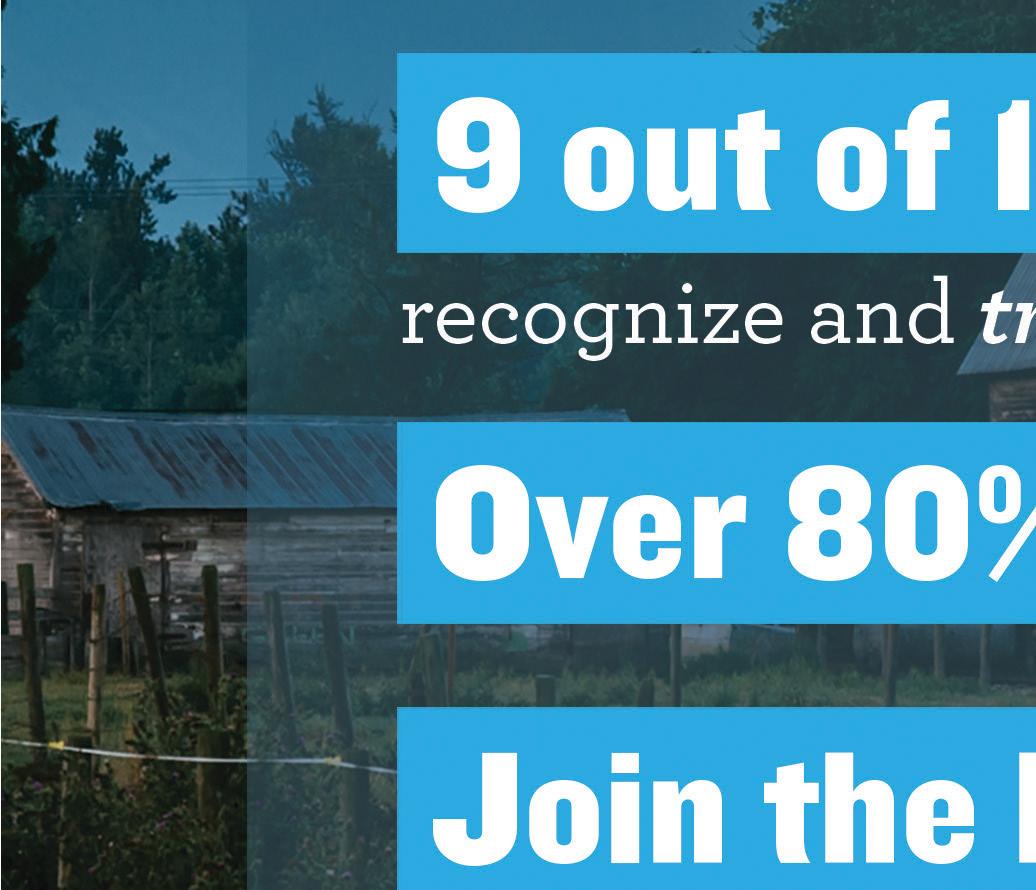











How these Toronto-based partners turned a lockdown idea into a zesty sauce and condiment business
By Andrea Yu • Photography by Jaime Hogge
WHEN COVID HIT, Jannine
Rane and her partner Anush Sachdeva were working busy jobs in Toronto’s tech and finance industries. “At the end of a workday, we’d look at each other and say, ‘What’s for dinner?’” Rane recalls. “That would cause friction and an argument about who’s making it and what we were going to eat that night.”
Rane and Sachdeva began thinking about how much they loved their city’s diverse food and how restaurants were able to make delicious meals quickly. They realized complex flavours were achieved in the form of seasonings and sauces to deliver a lot of flavour in little time. “The secret sauce is really the secret sauce,” says Rane.
In the summer of 2020, the duo brought their chef friend, Kiran Singh, on board to help develop “flavour shortcut” sauces and seasonings inspired by the many global communities that have made their home in Canada. First came their Hakka-ish Chili Crisp. It was inspired by Toronto’s Indo-Hakka Chinese diaspora—communities of Hakka Chinese descent who migrated to India and later to Canada—whose cuisine blends Chinese techniques with Indian spices and heat. It went through 10 different iterations before they settled on the perfect recipe. They also created a second sauce, the Mogambo Roasted Garlic Condiment, which was inspired by Indian and North African flavours. It was made using French culinary techniques and was born out of Rane’s displeasure with chopping garlic. There was also a line of three seasonings: the Zesti Jerk Seasoning, Smoki Garam Masala and Ooomami Savoury Seasoning Salt.
The company, named Zing Pantry Shortcuts, first launched in October 2020, selling direct to consumers through e-commerce. Zing quickly sold out of some products, boosted by positive press coverage. “That helped give us the confidence that it is something that people might want, and it’s worth investing in,” Rane explains.
In the spring of 2021, Rane began exploring retail partnerships with independent shops in Toronto, including the Dark Horse Espresso Bar chain and Sanagan’s Meat Locker. “We were really moving through word-of-mouth,” explains Rane. “Customers were recommending us to their local retailers.” By the end of
2021, the company had about 50 retailers on board, mostly in Ontario, with a few spots across the country and in the United States. That year, Zing also added more sauces and seasonings to its lineup, including Buzz Hot Honey, which was developed with bestselling cookbook author and executive chef Christine Flynn. It was the first in a series of sauces co-developed with Canadian chefs and food personalities.
Sachdeva and Rane’s backgrounds in tech helped inform the way the company grew; for example, the creation of their public test kitchen. “It’s a group of real consumers and tastemakers, everyone from food journalists to buyers to Michelin star chefs that will try product prototypes, so to speak, and provide feedback on what’s working and what’s not,” Rane explains. “We are very methodical—we like to make small bets, fail fast and grow from there. That iterative approach has been really the DNA of how we’ve operated from day one.”
In 2022, Zing got its first “yes” from a major grocery chain—Whole Foods Market Canada—launching in all its Ontario stores. “They really gave us our first big break and their stamp of approval,” Rane says. “That opened the door to a lot of opportunities for us.” One of those opportunities was connecting with a national food distribution company, Jonluca Neal. By the summer of 2023, Rane quit her tech job to run Zing full time. “We had enough signs and signals from sales and from the community to show me that we had done enough to take the leap,” she explains. The year continued to be a great one for Zing, with its products launching in a few more Ontario grocers including 24 Fortinos stores and nine Goodness Me! locations. Then, in June 2024, they added 48 Farm Boy locations in Ontario and 14 IGA and Fresh St. Market stores in British Columbia and Alberta. This was followed by Healthy Planet locations in Ontario in November 2024 and most Metro Ontario locations in May 2025. And there’s more to look forward to in 2026, as they’ll expand their reach with Whole Foods to 14 stores nationally, along with launching a line of Asian-style barbecue sauces. Looking back, Rane admits she never intended to start a company. “It was a pandemic project, but one thing led to another and here we are,” she says. “We were in the right place at the right time, with a little bit of the unexpected.” CG
30 seconds with …
What has been your best day in the business so far?
When we got our first order that wasn’t from friends and family. Nothing’s going to top that one. Just the idea that someone, somewhere, thought what we were building was worth buying.
What’s the best business advice you’ve received?
Just do it! Just try! A lot of the time, people have great ideas but are hesitant to execute on them. The biggest unlock for us has just been to put yourself out there and try. Don’t hesitate to take a big swing.
What has been the biggest growing pain in your business?
We come from non-CPG backgrounds, so learning the ins and outs of CPG has been something that we’ve had to do as we go.
What’s your favourite product from your lineup?
That’s like picking a favourite kid! It changes often. I have a soft spot for the original Hakka-ish Chili Crisp because that’s the first product. I put it on my eggs. But, I think the underdog in our lineup is our seasoning salt, Boom. It’s like a coming together of South Asian spice blends that are lentil-based and Mexico’s smoky chilies. I’m using that a lot these days to season chicken.






MosT Canadians believe tariffs will have negative short- and long-term impacts on the economy and continue to affect their grocery spending, according to a new study by NielsenIQ (NIQ).
The North America Tariff Sentiment Study: U.S./Canada Topline found 76% of Canadians expect tariffs will have a negative impact on the economy this year and 72% expect they will have a negative impact over the next three years.
Not surprisingly, 85% of Canadians disapprove of tariffs while only 6% favour them and 9% are unsure.
The study was the third of four NIQ fielded this year to gauge Canadian and U.S. consumer sentiment around tariffs. In Canada, 5,002 English and French speaking consumers were surveyed between Aug. 1 and 11.
Mike Ljubicic, managing director of NIQ Canada, says tariffs are just one of the factors, along with inflation, increased commodity prices and economic uncertainty, that are putting pressure on consumers’ wallets.
The study found Canadians are most concerned about the impact tariffs have on the prices of fresh produce (49%), followed by poultry (40%) and dairy and eggs (both at 39%).
Ljubicic says many cash-strapped consumers who oppose the U.S. tariffs would like to buy Canadian at the grocery store, but have to opt for lower-priced American goods. “They have to make
a decision based on how much money they have in their wallets.”
That, he says, helps explain why the percentage of Canadians who said they would avoid buying U.S. products due to the tariffs has dropped from 36% at the beginning of the year to 29% in the latest survey.
The NIQ study also found 42% of Canadians say they are not eating out as much and 32% have reduced travel, partly due to the U.S. tariffs.
“People are just a little nervous about the future” and are being more frugal, Ljubicic says.
Consumers are controlling their spending by sticking to essentials and cutting back on discretionary spending, buying on promotion, shifting to private label and shopping at discounters, he says.
Even households with incomes above $70,000 are being prudent. “They’re the ones that are driving the growth in the discount sector,” by shopping at “hard discounters” such as No Frills, FreshCo and Food Basics.
Ljubicic does not expect a bounce back from discounters to conventional grocers for the foreseeable future. “I think discount is a new norm that’s here to stay,” he says. “We will continue to see expansion and conversion into those types of outlets because that’s where the traffic is going.”— Danny Kucharsky









INDEPENDENT GROCERS KNOW better than most that the unexpected can quickly disrupt business—from a refrigeration breakdown that spoils thousands of dollars worth of inventory to a flood that forces the store to close its doors.
A recent TD Insurance survey shows that while nearly all Canadian small business owners carry insurance (94%), more than half (52%) said they would still rely first on financing, such as credit cards or loans, in an emergency.
For grocery retailers, 56% indicated they would reach for credit cards and 27% would rely on family and friends. With grocers already facing tight margins and rising costs, that gap between coverage and confidence could make recovery harder than it needs to be.
SO WHY DOES THAT GAP EXIST?
“What stood out in the survey was that grocery and convenience retailers were among the least confident that insurance would help them in a crisis,” says Tang Trang, vice-president, product and pricing, small business insurance at TD Insurance. “I think there are several misconceptions, and one is if you use your insurance, maybe my premium will go up, maybe you won’t be able to get it next year (which is untrue). So, there is a lot of fear.”
Another issue worth noting, says Trang, is that retailers sometimes buy insufficient insurance or even the wrong kind for their situation. And in some cases, they think they have the wrong kind of insurance and it won’t cover their particular situation or that it won’t cover
smaller issues. Trang compares it to buying a tablet and using it only for writing or scrolling. “It has a thousand features and you use only 1% of it.”
With 27% of surveyed grocers saying managing cash flow and finances was their biggest business challenge, Trang points out that insurance doesn’t just protect against loss—it preserves cash flow and provides critical liquidity in times of crisis when small business owners need it.
Trang gives the real-life example of an independent specialty food store that had a power outage resulting in a freezer shutout and spoiled meat. Within 30 days, insurance was able to replace the inventory, ensure the freezer was functioning and offer advice on getting a generator.
Trang recommends retailers maintain accurate inventory records and promptly and carefully document any incidents. If there is a loss, this will help expedite insurance claims and get business owners back on their feet quickly.
He also recommends that retailers don’t think of insurance as “one and done.”
“Every business changes over time, and you may be wanting to grow your business, so you may need more insurance or a different type of insurance,” he says.
By meeting with an advisor to understand their coverage and plan for both everyday risks and major disruptions, he adds, grocers can reduce reliance on costly emergency financing and focus on what matters most: keeping shelves stocked and customers satisfied.
—Louise Leger
Thirty-nine per cent of Canadian workers report feeling burnt out at work, according to a new national survey by Mental Health Research Canada, Workplace Strategies for Mental Health, and Canada Life.
The survey’s authors call the rise of burnout (up from 35% in 2023) “troubling,” noting it’s not just a wellness issue—it’s also a business issue. Burnout costs employers between $5,000 and $28,500 per employee, annually.
According to the report, companies that prioritize prevention see a 27% burnout rate versus 47% for those taking no action, resulting in potential savings of $1.7 million per year for a 500-employee company. “When organizations invest in prevention, they don’t just protect their people, they protect their bottom line,” says Mary Ann Baynton, director of collaboration and strategy, from Canada Life’s Workplace Strategies for Mental Health, in a press release.
Other findings from the survey: ONLY
42% of employees with a mental health diagnosis disclose it at work fearing career consequences
46% of employees say burnout prevention is not a priority at their workplace
3 IN 5 managers report their workplace provides them with the tools/skills to effectively manage emotionally distressed employees
Time-based supports like paid time off and flexible schedules are more effective in tackling burnout than awareness campaigns
Star Women in Grocery recognizes the incredible women shaping Canada’s grocery industry. We thank our sponsors for their support in celebrating these trailblazers.







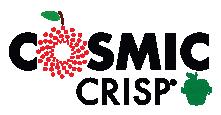












Even at the highest levels of leadership, female executives wrestle with self-doubt. And it can creep in regardless of business results or professional track records. Resilience and strong working relationships can help counteract these feelings and enable people to embrace challenges outside their comfort zones.
At Canadian Grocer’s Star Women in Grocery Awards ceremony, this theme resonated as some of this year’s winners (and a past honouree) took to the stage to share how they’ve faced self-doubt, how collaboration helped them overcome it, and the importance of mentorship in shaping the next generation of executives.
By Kristin Laird
“People often assume that senior leaders must be perfect and have never doubted themselves, and that is not true. I think everyone has faced self-doubt at some point, but it’s how you learn to shift your mindset … Eventually, I learned to bet on myself, to trust my experiences, my higher success and my ability to grow into whatever came next.”

Cara Keating, CEO, PepsiCo Canada
“Sometimes imposter syndrome stays there, so a lot of the leaders and mentors I’ve had the fortunate opportunity to meet on my journey have helped me see my blind spots, have encouraged me to take risks that I may not have taken or didn’t think I was ready or capable of taking, and those risks have, ultimately, opened up new opportunities and have helped me grow along my journey. And that is something that is so pivotal.”

Erika DeHaas, vice-president, corporate marketing, Sobeys

“I have definitely felt imposter syndrome. Imposter syndrome is not necessarily something you get over and you’re done with [it]. You have to work through it consistently throughout your career. A few things that have helped me is reframing a lot of the discomfort and the doubting into growth. It’s like, ‘OK, I know I’m in an area that’s not as familiar—that means I’m growing. That means I’m learning.’ And the other thing is finding your people. I’ve been very fortunate in my career to have incredible leaders, bosses, peers … and I can go to them and trust they can tell me when I’m being hard on myself.”
Amanda Galante, senior category director, centre of store - super market division, Loblaw
“As leaders, we all have a role to play to help others find their path. And I think it’s important for us to always make sure that in a busy schedule, we carve out time for other people, to guide, to mentor—because for me, there’s nothing more rewarding than seeing someone you coach or guide who is thriving and succeeding. I’m super grateful for the opportunities I have, but mainly the leaders that crossed my path … it makes a huge difference.”

Marie-Eve Girard, senior director, commercial strategy and channel development, Danone Canada

“I try and remind myself that resilience isn’t new and it’s not just a skill we need to start developing at a certain stage in our career or a certain stage of life. We’ve been practicing resilience our entire lives. If you go back to making your first friend, surviving high school or figuring out life in your early 20s, we’ve been practicing that skill for a long time. It’s a good reminder to myself and to anybody else to say, ‘We’ve already been through many challenges, and you got to here today.’”
Hali Burness, senior director, finance, Conagra Brands Canada

Connections were made, stories were shared and inspiration was sparked as Canada’s grocery industry came together in Toronto on Sept. 25 to recognize Canadian Grocer’s 2025 Star Women in Grocery winners.
A sold-out crowd of more than 700 attendees was on hand to recognize this year’s 60 winners for their remarkable career achievements and contributions to the industry.
The morning kicked off with a keynote presentation from PepsiCo Canada’s chief executive officer Cara Keating—and a 2017 Star Women in Grocery winner—on leading with authenticity, owning your accomplishments and creating space for team members to succeed.
Next, as part of a panel discussion moderated by editor-in-chief Shellee Fitzgerald, four of this year’s winners—Erika DeHaas (Sobeys), Amanda Galante (Loblaw), Marie-Eve Girard (Danone Canada) and Hali Burness (Conagra Brands Canada)—shared the importance of adaptability and resilience, learning to accept feedback and maintaining a work-life balance.
The event wrapped with Empire chief executive officer Michael Medline presenting the inaugural Icon Award to Retail Council of Canada’s retiring president and CEO Diane J. Brisebois, acknowledging her impact and industry-shaping achievements. CG




































This year’s Star Women Networking Lunch featured a powerful presentation from Tonia Jahshan, a trailblazing entrepreneur and advocate for women’s mental health. Tonia, recognized by Ernst & Young as one of Canada’s top entrepreneurs, grew her company Sipology into a multi-milliondollar health and wellness success. Her story is a testament to how resilience and vision can transform challenging moments into positive outcomes.
As Vanessa Peters, Publisher of Canadian Grocer, noted, “In sharing her personal journey, Tonia showed us it is okay to make mistakes, but not okay to sacrifice our health and wellbeing. Women can do great things, but we have got to look after ourselves as we build our companies and careers. That is why events like this are so important, because they help to build a supportive community.”

“The Star Women Networking Lunch capped off a wonderful day where we celebrated a deserving group of women for their hard work,” added Peters, “It is a privilege to give them a little something back.”



Caddle research reveals how deals, loyalty and shifting mindsets will shape the peak retail period
While inflationary pressures continue to influence wallets, Canadians are determined to celebrate.
Almost half (46%) say they are shopping more selectively but still want to enjoy the season
The holiday season has always been a high-stakes battleground for Canadian retailers but, in 2025, shoppers are entering with a mix of caution, creativity and resilience. According to Caddle’s latest research, conducted in August, Canadians are not opting out of holiday celebrations, but they are redefining how and where they spend. With advertising costs peaking and consumer attention fragmented, the pressure on brands to show up with the right value at the right moment has never been greater. For retailers, the insights paint a clear picture: the holiday shopper journey is earlier, more digitally influenced and more selective than ever before.
Forty-two per cent of Canadians say they begin shopping in November or earlier, while another 18% admit they wait until two weeks before the holidays to shop. That leaves retailers balancing both early planners and last-minute scramblers—a dual mindset that calls for consistent, extended promotions across the calendar. Black Friday and Cyber Monday remain the centrepieces. Nearly 1 in 3 Canadians plan their holiday spend around this window, with millennials (39%) and generation Z (38%) leaning most heavily on these tentpole events. Older generations, by contrast, are more likely to spread their purchases into December.
While inflationary pressures continue to influence wallets, Canadians are determined to celebrate. Almost half (46%) say they are shopping more selectively but still want to enjoy the season, and another 34% report they are cutting back to essentials. Only a small minority (5.5%) say they are skipping most
shopping altogether. The focus on value is strongest among younger Canadians. Generation Z (49%) and millennials (47%) are the most deal-driven, reporting that discounts matter more this year than in previous seasons. Older cohorts (baby boomers and the Greatest Generation) are less swayed by price tags alone, leaning instead on loyalty and familiar retailers to guide decisions.
Food, drinks and hosting represent a large share of seasonal spend, with baby boomers leading in grocery purchases, while generation Z and millennials allocate more toward parties and travel. This broadening of budgets underscores the need for retailers to think holistically about holiday baskets.
Despite the growth of e-commerce, big-box in-store shopping remains dominant, with 35% of Canadians saying they plan to do most of their holiday shopping at major retailers. That said, 28% will shop online through the same big retailers, and younger cohorts are increasingly turning to social platforms to discover and purchase products—with 12% of generation Z and 9% of millennials saying social commerce is their channel of choice. Inspiration also varies by generation and region. Retailer websites and apps lead overall, especially for baby boomers (41%), while in-store signage remains a powerful trigger for older shoppers. Social media is nearly 1.5 times more influential for generation Z than baby boomers, highlighting the need for multichannel strategies that adapt to shifting discovery habits.
For all the excitement, holiday shopping isn’t without frustrations. High prices top the list, discouraging 51% of Canadians. Crowded stores (32%) and out-of-stocks (17%) also rank high as barriers, reinforcing the importance of seamless in-store execution. When asked what makes for a standout in-store experience, Canadians say clearly marked promotions (48%), fast checkout (28%) and helpful staff (23%) define success. These fundamentals, while simple, are essential for building trust and keeping shoppers engaged through a hectic season.
The 2025 holiday season is less about unchecked splurging and more about balancing joy with pragmatism. Shoppers want deals, but they also want reliability. They are looking for trusted product information, convenient experiences and brands that respect both their budgets and their time. For retailers, the opportunity lies in meeting shoppers where they are—both early and late, online and offline, price-sensitive and loyalty-driven. Those who combine sharp promotions with consistent omnichannel messaging, well-stocked shelves and service that reduces friction will not only capture share of wallet this season, but set the stage for lasting loyalty well into the new year. CG

Lantic undertook an ambitious modernization of its retail pouch line in 2024. The goal for this project was to re-introduce the full line-up to the market aligning with their sustainability goals - making each pouch recycle-ready certified. This maple pouch duo is the latest to go to market. In addition to giving both a fresh new look and sustainable features, Lantic gave Maple Flakes a new nameMaple Crunch to better reflect its nature.

Activia, the pioneer in gut health and the #1 doctor-recommended probiotic food and beverage brand* in Canada, proudly unveils Activia EXPERT— its most advanced yogurt yet. Backed by Activia’s over 35 years of global research in gut health, this new product line is the first of its kind in Canada, combining an exclusive blend of probiotics with prebiotics.
*#1 Recommended brand of probiotic Food and beverage by Doctors (Family Doctors, Gastroenterologists, OBGYNs, and Internal medicine Doctors) based on a 2024 blinded survey amongst a representative sample within doctors. The results were statistically significant at 95% confidence intervals.
Introducing OÎKOS Pro™ Caramel Macchiato High Protein Drinkable Yogurt –Oikos’s first coffee flavoured drinkable yogurt! Crafted for those seeking a delicious and rewarding experience, this drink is ideal for post-workout recovery1 or a quick snack during the day, offering a delightful caramel coffee taste.
1Oîkos PRO™ drinkable yogurt 300 mL is a source of protein. Protein helps build and repair body tissues.



Yupik, a family-owned Canadian brand, is the fastest-growing name in premium snacks and ingredients. Known for innovative products like Cosmic Cashews, Maple Chipotle Almonds, and Bloody Mary Cashews, Yupik offers versatile snacks as well as family-sized formats. Yupik delivers shelf-ready solutions that meet evolving demand and maximize retail impact, helping retailers and distributors stand out. Discover more at yupik.com

The rise of value-driven formats and rapid e-commerce growth are reshaping how people shop
While Canadian retail is projected to grow at a 3.3% compound annual growth rate through 2030, value formats are expanding even faster
KANTAR’S LATEST FIVE-YEAR forecast reveals a dramatic transformation in Canada’s retail landscape. Three forces are driving this shift: the rise of Costco as a market leader, the rapid expansion of value formats and the accelerating growth of e-commerce. For brands, understanding these dynamics is essential to capturing growth in an increasingly competitive environment.
Costco is on track to surpass Loblaw in sales by 2030. This shift reflects Costco’s consistent performance and its ability to deliver both value and quality, particularly through its private-label brand, Kirkland Signature. Over the past five years, Costco’s growth rate has significantly outpaced that of Loblaw. The warehouse club has emerged as a key grocery destination, especially among new Canadians who increasingly recognize its appeal for value and product quality. Rising trip frequency and strategic club openings nationwide have further accelerated Costco’s expansion and relevance. For brands, this underscores the importance of aligning with retailers that offer affordability while maintaining a premium perception.
While Canadian retail is projected to grow at a 3.3% compound annual growth rate through 2030, value formats are expanding even faster. Discounters are no longer competing solely on price. They are evolving to meet broader consumer needs, including indulgence and convenience. Retailers such as Dollarama, Dollar Tree and Giant Tiger are driving
shopper satisfaction and loyalty by delivering value, convenience and a compelling product assortment at low-entry price points. Among shoppers of Metro’s Food Basics discount banner, 43% agree that pantry grocery delivery has improved; the figure is 41% for Giant Tiger shoppers. Chocolate and sweet snacks consistently rank among the top-performing merchandising groups at both Dollarama and Dollar Tree, reinforcing their role as key snack destinations for budget-conscious households. While rankings vary by region and season, these categories remain central to shopper missions.
Digital commerce is expected to account for roughly one-third of incremental retail dollars over the next five years. Amazon and Walmart are projected to capture nearly two-thirds of online sales among Canadian online retailers. Also, Amazon stands out as the most cross-shopped retailer, reflecting its broad appeal and robust fulfilment capabilities. While delivery remains the dominant method for online orders, remote pickup and buy-online-pick up-in-store options are gaining traction. Both French Canadians and multicultural Canadians are showing increased adoption of online retail compared to last year. For brands, the implication is clear: offering multiple fulfilment options is essential to meet diverse shopper preferences and capture share in an increasingly omnichannel environment. The baby category illustrates how digital channels are reshaping consumer behaviour. Baby food fulfilment is balanced between online and physical platforms, reflecting a decisive pivot toward embracing e-commerce. Online sales for baby food are driven by exclusivity, premium organic assortments and superior shopping experiences. Walmart and Costco remain dominant destinations for these categories, both online and in store, reinforcing the need for integrated channel strategies. Brands that fail to optimize their digital presence risk losing relevance in a category where convenience and quality are paramount.
Value and online channels will capture the majority of incremental retail dollars through 2030, outpacing traditional formats. To remain competitive, brands must prioritize partnerships with high-growth retailers such as Costco, Dollarama, Giant Tiger and hard grocery discounters. They must also invest in robust digital capabilities to capitalize on the accelerating shift toward e-commerce. Aligning strategies with key performance drivers, including value, convenience and assortment, will be critical to sustaining shopper loyalty and driving long-term growth. CG
Amar Singh is a senior director at Kantar Retail. He creates insights that inform strategic decisions about key drug, home improvement, discount, convenience, grocery and digital channels. Amar is a seasoned brand, shopper and advertising researcher.


Whether it’s a morning ritual, a moment to unwind, or a chance to connect with friends, coffee has become more than a caffeine boost. It’s an experience. In fact, Canadians’ love affair with coffee shows no signs of slowing. According to the Coffee Association of Canada (CAC), 74% of us enjoyed a coffee yesterday—more than any other beverage, including tap or bottled water and tea. Espresso-based beverages gaining favour
Espresso-based beverages (EBBs) such as cappuccinos and lattes have reached an all-time high in Canada, with 30% of Canadians enjoying at least one espresso-based drink yesterday, according to CAC data. This trend is expected to continue throughout 2025, driven largely by Gen Z and millennials who enjoy café-quality drinks at home or on the go.
Younger coffee lovers are also changing when and how they drink coffee. Cold brew and nitro options are now sought after year-round—even in winter—indicating that Canadians are expanding their appreciation for coffee beyond the traditional hot cup.
Bring on more
Another trend percolating in the category is the surge in flavoured coffees. Younger generations are leading
the charge, asking for new tastes across all formats—from roast and ground to pods. “We see classics like caramel returning season after season, alongside limited editions that invite consumers to explore,” notes Roberto D'Elia, Director of Canada Retail Sales at Lavazza. “That’s why we entered this market in 2025 with the launch of two flavoured Nespresso* compatible capsules, Caramel and Chocolate-flavoured espresso—and there’s more to come.”
Both roast-and-ground and coffee pods are gaining in popularity. The former remains a staple for everyday use, while the latter appeals to consumers who want speed, convenience and consistency. Together, they’re fuelling renewed momentum for the coffee category in 2025.
This year marks 130 years since Luigi Lavazza opened his first store in Turin, Italy, to introduce his first coffee recipe. His curiosity and ingenuity led him to blend beans from different origins, and that spirit of innovation still drives the company today. “Believing that even excellence can be improved upon is one of our core values,” says D’Elia. “We bring dedication to everything we do, ensuring impeccable quality that exceeds expectations.”
Lavazza’s latest campaign invites Canadians to “feel the real coffee pleasure” by experiencing life the Italian way—one perfectly crafted espresso at a time. For more information go to https://www.lavazza.ca/en

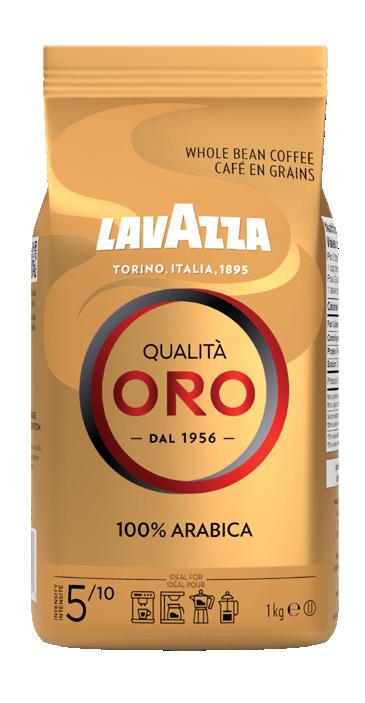

Lavazza Qualità Oro
First developed in 1956 and passed down through generations, Qualità Oro is a 100% Arabica blend featuring six of the finest beans from Central and South America. The result is a symphony of fruity and floral notes, an intense aroma, and a velvety golden crema that reflects Lavazza’s enduring passion for quality.
The Golden Pencil Awards will be handed out at Toronto’s Fairmont Royal York on November 24. For tickets visit groceryconnex.com
A grocery chief credited with turning around Empire’s business, a passionate leader of a foundation dedicated to combating child hunger, and a former Olympian turned CPG executive are among this year’s recipients of the Golden Pencil Award. First presented in 1957 by the Food Industry Association of Canada, the Golden Pencil is awarded annually to exceptional leaders for their contributions to the grocery industry and their communities. Read on to learn more about this year’s winners: Empire’s Michael Medline, The Grocery Foundation’s Shaun McKenna and Gary Wade of Unilever Canada, and discover why they’re worthy of this prestigious accolade.
By Shellee Fitzgerald and Kristin Laird • Photography by Mike Ford
“LONG AND WINDING,” is how Michael Medline describes his path to leading Empire and Sobeys. “I wasn’t sure really, when I was younger, what I wanted to do … I was always trying to figure out the next thing that I wanted.”
Medline’s circuitous journey began with a degree in history—“great training to read, write, communicate and think through things logically”—followed by law school then an MBA, which he pursued to better understand “the nuts and bolts of business.” Early in his career, he landed a role at McCarthy Tétrault, one of Toronto’s top law firms practising corporate securities law.
“Although I liked the law, I was always jealous of the people on the other side of the table who were doing the business side,” says Medline. So, he shifted to the business side, first as corporate counsel for Pepsi, then on to Abitibi-Consolidated where he was given opportunities to run different areas of the business, including supply chain, purchasing and strategic planning. What followed was a 16-year stretch at Canadian Tire, where he rose through the ranks to become CEO. “When I left [Canadian Tire], I had to figure out, again, what I wanted to do.” Sobeys had long been on his radar. “I’d always wanted to work at Sobeys because I really liked the culture,” he says, so when the opportunity to lead the company came up, he jumped at the chance and has been at the helm since 2017.
One lesson his journey has taught him: “You don’t have to have everything figured out, all the time … work hard and put your head down and see where your career takes you.”
Among his many achievements, Medline says he’s particularly proud of Project Sunrise, the three-year transformation initiative to turn around Empire’s business. “It was both an awesome responsibility and a thrill,” says Medline, noting the success of the project was not assured at the outset. “But pretty quickly, I thought we had a real chance to be highly successful,”


he explains, noting the stakes were high—more than 120,000 team members were counting on the project to work. “We didn’t want to let them down.”
It was also a time when tough decisions had to be made, he says, acknowledging that “many great people” were let go for “the good of the whole.” Medline’s takeaway: “Treat people like adults. Don’t try to fool them with words. Tell them what’s going on, what you’re facing, what has to happen—and then treat them with unbelievable respect.”
Medline credits his father, Alan—a doctor “who has never missed a day of work”—for instilling his strong work ethic. And when asked what he attributes to his success, he notes two things: “One is that I never give up, ever. Even when the chips are against me, I just keep on going,” he says. The second is making time to talk to people, both inside and outside the company, and learning from them. He says it’s important to be humble and acknowledge you don’t know everything—there’s always much to learn.
Earlier this year, Medline announced he’ll retire from Empire next May. What will he miss? The people, the team and the frenetic pace of grocery. “There’s nothing like retail and certainly nothing like grocery retail … you never know what the next day is going to bring and I think I’ll miss that excitement.”



The board of directors of The Grocery Foundation, along with the dedicated community of grocery retailers, food and beverage manufacturers, and our esteemed industry partners and colleagues at the Foundation, extend our heartfelt congratulations to Shaun McKenna and Michael Medline on receiving your Golden Pencil Awards. Your exceptional leadership and the significant impact you both have had on our industry and the lives of children across the nation is truly inspiring and will leave a tremendous legacy.




















A GRADUATE OF Ivey Business School at Western University in London, Ont., Shaun McKenna says his “real” education came from running his own painting business while a student.
“There’s no better motivation than necessity—I needed to make the money to get back to school, otherwise I wasn’t going to be able to get back,” says McKenna. That experience, he adds, taught him responsibility and resilience at a young age.
The experience also sparked his entrepreneurial spirit. After starting his career at Coca-Cola Bottling straight out of school, six years in he was looking for a new challenge. He found it at CIM, a startup sales and marketing agency he helped build over the course of 15 years. In 2012, McKenna and his partner sold CIM to Mosaic, where he went on to lead the company’s sales business. When Mosaic was later acquired by Acosta Sales & Marketing, he became the president of the company’s Canadian business and later held an executive role on the U.S. business.
While serving as a board member of The Grocery Foundation—a non-profit organization that brings together retailers and CPG companies to combat child hunger and support youth well-being—McKenna seized the opportunity to become executive director when the role opened up in 2017. “I wanted to pursue my moral ambitions,” he says. “I wanted to give back and do something a little more rewarding.”
Under McKenna’s watch, the Foundation has achieved remarkable growth. Its Make Happy Tummies fundraising platform has expanded not only geographically—now reaching Quebec, Atlantic Canada and Western Canada, in addition to Ontario—the number of participating stores has increased from 400 to 1,700, while corporate sponsors have jumped from 14 to more than 40. “We’ve had great growth,” says McKenna. “I’m proud that we’re doing something good for kids—that I’ve played a role, have helped lead that [effort].”
Leading the Foundation, he adds, has also given him a


“unique” vantage point to see the grocery industry come together—even competitors—to support a shared cause.
“They realize that by working together, they can increase their impact,” he says. “I feel privileged to have the bird’s eye view of the best of the industry.”
Born and raised in Hamilton, Ont., McKenna humbly attributes his success not to “any special talents,” but to hard work.
“In Hamilton, we have a term for that, you’re called a grinder— you’re willing to do whatever it takes and just grind it out.”
As for career advice that’s stuck with him through his more than 35-year career, McKenna recalls something a professor once told his class in his final year of university: “‘It’s on you to make your job interesting and exciting, not your employer, it’s on you.’ I’ve always believed that.”
Last month, McKenna announced that after eight years, he will be departing The Grocery Foundation next year. “I’m passionate about what we’ve built here,” he says. “It’s been a great ride.”

We are proud to celebrate Gary Wade, President of Unilever Canada and CEO of Beauty & Wellbeing, North America, for being recognized with the prestigious 2025 Golden Pencil Award.
Over 30 years with Unilever, Gary has driven growth, expanded market share, and strengthened the brand presence in Canada, demonstrating a commitment to sustainability, innovation, and consumer well-being.
Thank you for your leadership, Gary! - Unilever Canada
WADE President and CEO
BEING A CPG executive isn’t all that different from training to be an Olympic athlete—both require relentless discipline, a desire for growth, unbridled ambition, the stamina to perform under pressure and the ability to work as part of a team.
For Gary Wade, this is more than an analogy drawing parallels between two worlds that demand a lot of its players—it’s a lived experience. At the age of 22, Wade represented his home country of South Africa as part of the national kayaking team at the 1992 Summer Olympics in Barcelona, Spain.
“I had a mindset at the time, which was my whole life revolved around making that team,” Wade said during an episode of the Own Your Potential podcast in 2022. “I went to bed at nights thinking about making the team, I woke up in the morning, I was training two or three times a day. I put everything into it.”
Wade has demonstrated that same level of dedication, drive and ambition throughout his decades-long career with Unilever, a company he joined right out of university, earning him an extensive list of accolades and industry awards along the way, including the 2025 Golden Pencil Award.
“I come from a competitive sport background,” said Wade. “I get energy from winning, however you define winning, but winning in results and delivering results. I wanted to have enough bandwidth or breadth in my career that allowed me to lead an organization—big organization or small organization—doesn’t really matter, doesn’t really matter the industry. I really wanted to have autonomy and be able to lead an organization.”
Wade began his journey with the company in South Africa and


later moved to Canada as part of what he called “a three-year plan.” More than 20 years later, Wade has held many progressive sales and marketing roles, culminating in his appointment as president of Unilever Canada in 2017. Wade was now at the helm of a very large organization.
Wade has been credited with not only achieving strong commercial results at Unilever, but also demonstrating a deep commitment to sustainability, innovation, consumer health and wellness, and equality in the workplace. He has been a champion of creating a safe, inclusive environment that embraces diversity in all its forms—including religion, sex, gender and physical ability.
“Sometime in the future, I will no longer be in this role and Unilever will have someone who is equally equipped to do the role,” said Wade. “I really want to make use of the time that I have to make change in our industry.”
In 2024, his role expanded to include CEO of Unilever’s Beauty & Wellbeing division in North America. In this dual role, Wade now leads the company’s operations across both Canada and the United States.
Wade’s career has been defined by strategic vision, leadership and impact, and his desire to continue to grow remains strong— like that of a former athlete. “You know, there’s still many things I want to do in my professional career,” said Wade. “I might not get to those goals or ambitions … But the journey is as much part of it as the destination. Knowing that every day you’re just going to get a little bit better, try a little bit harder [and] overcome setbacks is fulfilling in itself.” CG
from your friends and colleagues at Empire Company Limited on being recognized with the 2025 Golden Pencil Outstanding Service Award.

Michael Medline has played a defining role in charting a bold path forward for Empire Company Limited — strengthening our commitment to teammates, customers and communities across Canada, while also serving as one of the staunchest and most passionate advocates for the growth and progress of our country’s grocery industry.

As retail crime escalates, grocers look for new ways to fight shrink
By Rosalind Stefanac
HETHER IT’S MIS-SCANNING at the self-checkout, organized theft rings or cybercrime, loss prevention is becoming harder and harder for grocers to tackle. According to Retail Council of Canada (RCC), retailers reported an average shrink of 1.5% or $9 billion in 2024, nearly double what it was five years prior. In fact, RCC says losses for Canadian retailers are now in line with shrink levels in the United States.
Fuelled by opportunity, today’s shoplifters are also getting increasingly sophisticated, operating in co-ordinated groups and finding new vulnerabilities to exploit in grocery, be it in-store or online.
But as theft evolves and losses escalate, so do the strategies to stop them. Across the country, grocers are looking to smarter store design, new technologies, better staff training and closer collaboration with police and government to keep loss—and risks—in check.
With a greater shift towards automation, grocers and retailers across the board cite self-checkout as a top contributor to shrink. Retail loss-prevention expert Stephen O’Keefe,



from your friends at Congratulations Michael Medline, Shaun McKenna and Gary Wade on your 2025 Golden Pencil Award!
president of Bottom Line Matters based in Georgetown, Ont., says self-checkouts are a prime example of technology implemented to improve the customer experience and save labour costs, with security as an afterthought. “I did a study on a 20-store project that showed that self-checkout added 36% more shrink compared to stores without it,” he says. “It’s really about opportunity and the perception that you’ll get away with it.”
Even as technology around self-checkout security improves, O’Keefe says grocers still need to figure out their trade-off between labour cost-savings and increased loss, and if “the math makes sense.”
On top of individual theft, organized crime is another factor contributing to significant shrink for Canadian grocers, especially in major cities such as Toronto and Vancouver. Industry experts say the combination of demand for lower-priced items and the sheer access to large volumes of perishable and non-perishable foods in a grocery store make it an enticing target. Labour issues in grocery are further compounding the problem with fewer employees to monitor grocery aisles and report incidences.
“We’re not talking about posting a wheel of cheese on [Facebook] Marketplace and having somebody buy it, but a very organized group of people who allow for the supply chain of stolen goods to get to market—and everybody along the way is making money,” explains O’Keefe.
Sylvain Charlebois, a professor in food distribution policy and senior director at the Agri-Food Analytics Lab at Dalhousie University, says “middle-mile” theft (where trucks are hijacked and products stolen as they move from warehouse to store), is a particularly costly problem that is difficult to police. “There is some potential with driverless trucks to reduce risks in the middle mile, but it’s still early days,” he says.
cybersecurity is becoming more of a priority for grocers, for sure, … the level of concern is uneven across the supply chain and that concerns me,” says Charlebois, noting that in his experience, manufacturers aren’t considering cybersecurity as big an issue as it should be.
Industry experts say assessing risk in your organization is the first key step. ECR Retail Loss is a Europe-based global think tank of retailers, suppliers and academics working together to tackle loss issues. It offers a free benchmarking tool for retailers on its website, ecrloss.com, developed by one of its academic researchers Emmeline Taylor—a professor of criminology at City St George’s, University of London—to help evaluate how secure their operations really are. The tool explores seven key principles—data, people, control, offenders, guarding, monitoring and joining forces—to generate a detailed security profile, and retailers report finding the process quite “eye-opening.”
Current data shows that grocers are certainly recognizing the importance of technology in loss prevention
As retailers respond to threats by adding more locked or glass-secured goods, body cameras or security guards, Charlebois says these actions carry the risk of turning off honest customers. “Canadians aren’t as used to visible security measures like Americans … so grocers have to be careful,” he explains, adding that if you make shoppers feel watched or distrusted, it changes the way they shop.
When large grocery chains receive backlash from the public for piloting new security measures such as body cameras on cashiers (as Loblaw and Walmart have adopted) or self-checkout barriers, he says, it can make other grocers hesitant to explore these options. “I think Loblaw’s anti-theft effort is often used as a weather balloon for the entire sector,” explains Charlebois.
Concerns around e-commerce crime and cyberattacks are another security concern plaguing grocers today. This past June, a highly publicized cyberattack on major food distributor United National Foods Inc. (UNFI) left Whole Foods Market and other grocers with empty shelves, putting food supplies at risk. Last year, Western Canada’s Federated Co-Operatives experienced a ransomware attack that impacted computer systems at hundreds of its grocery stores and gas bars for weeks. “While
Colin Peacock, the think tank’s group strategic co-ordinator, says reducing shrink takes a company-wide approach that starts with good data and prioritization. “First of all, you try and gather as much data as you can to figure out what stores are riskier than others,” he says. The data can help guide grocers on where to focus their efforts, from adjusting store hours and assortment in higher-risk locations to investing in training and empowering staff.
“Self-checkout hosts are one of the most important, but also one of the toughest jobs in the store,” Peacock notes. “Investing in the right people and training them to de-escalate tension and manage abusive customers is crucial.” He also highlights how new scan-avoidance and product-recognition technologies can help reduce loss, with some retailers seeing up to an 11% improvement in shrink so far and even better technology coming.
Current data shows grocers are certainly recognizing the importance of technology in loss prevention. According to 2025 research from the Food Industry Association (FMI)’s Asset Protection in Food Retail report, nearly half of retailers (48%) are now using data analytics for loss prevention, up from 37% the year before. Artificial intelligence is also gaining ground, with usage doubling from 10% to 22%.
Doug Baker, FMI’s vice-president of industry relations, says these tools help retailers spot patterns and intervene faster. Looking ahead, he expects electronic labels and tags to see continued growth, along with technology that supports product traceability and inventory planning. “It’s clear that the industry is leaning into smart, scalable solutions to stay ahead of shrink and operational risk,” he says, adding that fraud detection tools are also on the rise.
Peacock adds that effective loss prevention depends on leadership and culture as much as tools or tech. “Thinking about shrink as a choice is important—it’s a function of the choices you make from the CEO down,” he says, citing self-checkouts as


Our nation-wide network of financing experts is helping you transform the Canadian food and beverage value chain. If you process it, produce it, pack it or move it, we can help your food and beverage business start strong or take the next step.
fcc.ca/Food






a prime example. “All the research suggests that their adoption will increase loss; however, there is a significant reduction in labour with their adoption. Across the world, retailers see this trade-off and choose higher losses.”
In the meantime, RCC is focusing on the bigger picture in reducing retail crime by working with law enforcement and government. Through its national Retail Blitz initiative, which runs four times a year in partnership with police services across the country, the organization helps co-ordinate targeted enforcement efforts that track arrests, repeat offenders and violent incidents (see sidebar). The program has resulted in more collaboration between grocers and law enforcement with some communities beginning to see results.
Rui Rodrigues, executive advisor, loss prevention and risk management at RCC, points to cities such as Winnipeg that are seeing a decrease in crime after years of double-digit increases. “This gives us the win to be able to say what we’re doing is working,” he says.
Beyond enforcement, in its latest report, RCC is also advocating for legal and policy reform to address what it calls a
As grocery theft surges across the country, so does violence against grocery employees. What was once the occasional heated confrontation between a customer and staff member has escalated into legitimate safety concerns causing grocers to rethink store design, training and technology to safeguard their staff.
Retail Council of Canada’s 2024 report, Retail Crime in Canada: The Hidden Crisis Impacting Business, Communities and Safety, provides some hard facts around what is quickly becoming a safety crisis in Canada. Survey findings showed more than 76% of retailers reporting increased violence during thefts, and last year alone there were 121 weapons seized in RCC-led retail blitz operations with police and retailers across the country. Almost 18% of those arrested were repeat offenders, too.
RCC’s Rui Rodrigues says it’s no longer just the volume of theft that is worrying retailers, but the violence often surrounding it. “Now, there are people coming in with machetes and knives and there are
“revolving door” of repeat offenders, by calling on government to strengthen bail reform and sentencing guidelines under the Criminal Code for chronic retail offenders. It’s also urging retailers of all sizes to report even minor thefts, so police can better allocate resources and build intelligence on organized networks. Without that information, Rodrigues says it’s much harder to prevent repeat offenders and protect both staff and customers.
He points to international safety models, such as those used in New Zealand, where there is a single national police service that allows for more efficient collaboration across regions.
“While Canada’s multiple jurisdictions make that model challenging to replicate, it’s an example of how centralized co-ordination can improve results,” says Rodrigues.
Despite escalating retail crime, some encouraging news is the vast majority (93%) of grocery shoppers still feel their primary store is a safe place to shop and 91% appreciate the safety measures retailers have put in place, shows research from FMI. “That tells us grocers are implementing security in ways that are visible but not intrusive, and they’re doing it with clear communication and respectful engagement,” says Baker. “It’s not just about having cameras or gates; it’s about creating an environment where customers feel protected without feeling policed.”
incidences of guns being utilized, which is concerning from a safety perspective for employees and consumers,” he says.
Along with deploying security guards on-site, large chains in Canada such as Walmart and Loblaw are piloting bodyworn cameras on employees to help reduce violent incidents in-store. This past March, Loblaw announced plans to extend its bodycam pilot—first initiated in Alberta and Saskatchewan—to select stores in Ontario, British Columbia and Manitoba.
Loblaw noted the cameras will only be worn by trained asset protection representatives, third-part security, store management and additional team members where applicable. They will also be activated only when colleagues are faced with a situation where there is a risk of escalation and fear for one’s safety and/or the safety of others.
Overall, Rodrigues says retailers have reported significant de-escalation of threatening behaviour from consumers when they see themselves on a camera screen. “They either stop their behaviour or leave because they know they’re on camera,” he says, noting it is essential that people wearing the body cameras are trained in how to de-escalate risky situations.
Meanwhile, retailers in Australia are redesigning their entire stores and front-line
practices to help reduce the risk of violence to staff. This means ensuring stores are welllit, providing dedicated staff-only access routes that allow employees to move safely around the premises without dealing with customers, along with “safe” lockable back rooms and till cages in high-risk locations. Checkout barriers and signage setting clear behavioural expectations are also in use. Even small, well-placed interventions in-store are helping reduce confrontation and give staff a better sense of control and overall safety.
To curb grocery store violence going forward, Rodrigues advises grocers to report all incidents to police. “I think there is a misconception that there is no point in submitting a police report if there is no arrest or charge being laid, but it’s so important for intelligence gathering … and helping police know where they need to deploy officers,” he explains.
For smaller grocers with less budget for additional security measures, Rodrigues also advises asking local police for help on assessing their risk areas in and around stores and advice on how best to curb them. “All the police agencies I know of will come out and do this when they have time—and even talk to employees on site about safety measures,” he says. CG


the power of private-label brands and how Metro hits the mark with consumers
By Rebecca Harris
Photography Chantale Lecours
Private label is on the rise as consumers seek value and quality—and grocers’ store brands are delivering. We spoke with Annie St-Laurent—a 20-year Metro veteran who has been leading the private brands team since May 2024—about new developments in the grocer’s portfolio and why it’s private label’s time to shine. This interview has been edited for clarity and length.
Tell us about your career path and how you came to Metro.
I started working for the grocery industry when I was a university student. Right after I finished, I was hired at Metro—and I’ve been with the company for more than 20 years now. My earlier roles were in replenishment and central procurement negotiation, but for the last 15 years, I’ve been with the private-label department. The interesting part is that it’s an area of constant innovation and learning, and one where we’re facing a lot of challenges. So, that’s what’s keeping me in that role—and I’m loving it a lot.
Just over a year into your position as vicepresident, private brands, what’s been the biggest success, and what have you learned?
There have been many successes during the last year for private label. All our banners have continued to grow their penetration rate for private label during the last year, so that’s a good success. We have built a strong plan for increasing visibility around all our private-label brands. One of the big successes that I’m really proud of is the launch of our new Irresistibles branding. It was also an interesting year in terms of challenges regarding new legislation around product [front-of-pack warning labels], but so far, that has permitted us to reposition our product and our brands. It has forced us to review our recipes, making sure they’re a little bit healthier for the customer, and making sure we have the right product and the right branding.
Private label has been growing for years, but some say private label is currently “having a moment.” Why do you think it’s private label’s time to shine?
One of the reasons why [our] private label is so popular is we’re always bringing value for customers. We have listened to their needs—and they want to have value. They want to have a great price, but the quality that we bring to our products and the variety of our assortment are key drivers. Yes, there’s always the national brands that bring familiarity, security and trust for customers, but I think private label now is also bringing excitement and innovation. This is another reason why private label is growing.

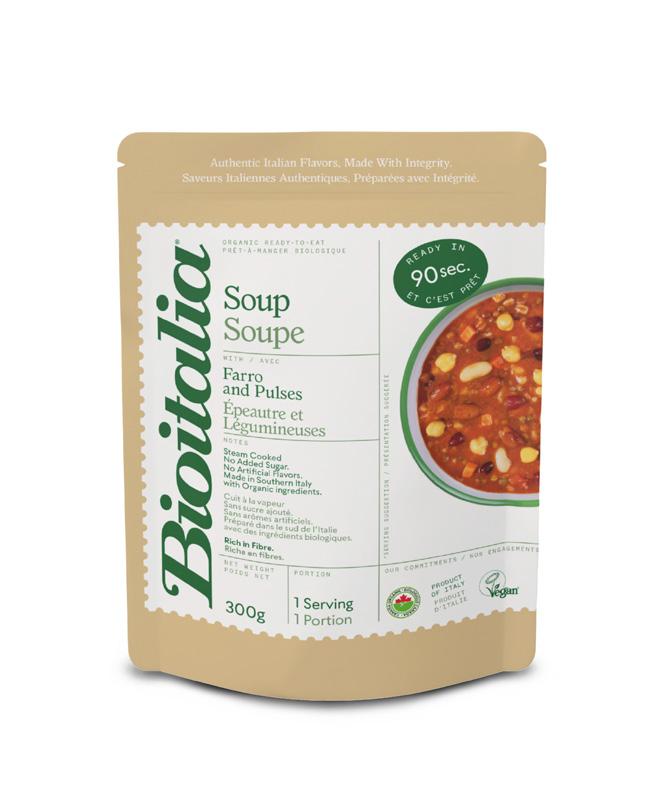
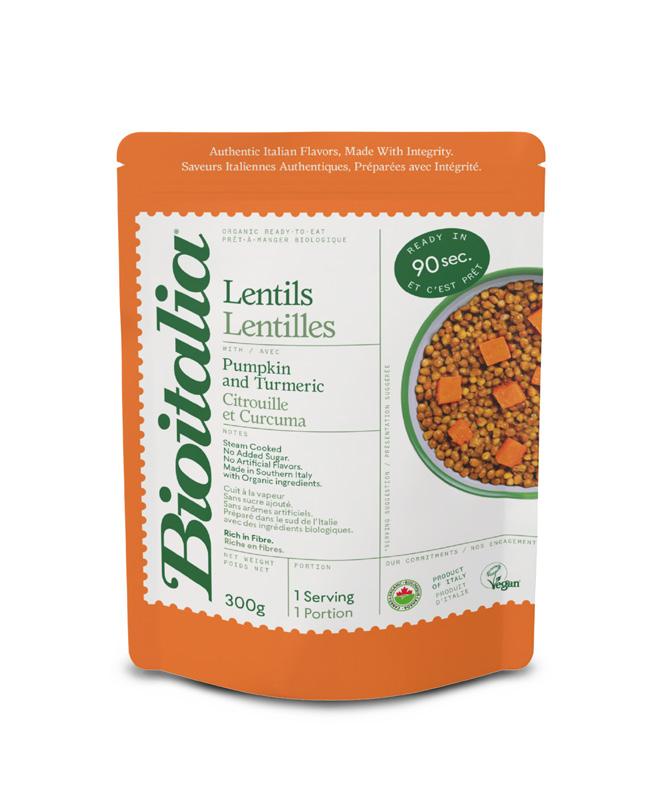




















Can you share your overarching strategy for Metro’s privatelabel portfolio?
I want to bring sustainable growth to my banner. We need our brands and products to have a purpose. So, our goal in private label is always to bring a true differentiation for Metro around our family of brands. We have the Selection brand—this is a category where the customer wants to have the best value for the price. Our Irresistibles brand is for the food lover, with products like hors d’oeuvres and frozen fruit. If you’re a customer concerned with health and wellness, we have the LifeSmart brand, which is a better-for-you option— better for you and for the planet, too. In pharmacy, we have a strong brand with Personnelle, which offers health care and over-the-counter products that bring trust to customers. In terms of strategy, we need to be careful about what the customer needs and demands and play around with our product and portfolio to make sure we bring them exactly what they need. So, we’re always focusing on those priorities.
What was the thinking behind the rebrand of Irresistibles and what results have you seen so far?
Irresistibles was always a good brand for showcasing our innovation and our exciting products. Unfortunately for us, the brand was unknown on the market and was not highly visible on shelf. So, the objective behind the rebranding was to make sure customers can see, understand, recognize and repurchase the products. We did studies to see the impact of our branding on the market. I’m proud to say the parameters that we measure are positive in terms of the products being easier to recognize in the store and purchase intent has increased. The growth of that brand is stronger than the rest of our portfolio—it’s performing really well in the market and the customer knows the brand now.
What are your plans for the other private-label lines?
For our other lines, I have four initiatives. I won’t give you any secrets today about whether we’re rebranding the others. But, for sure my focus is on keeping fair pricing for all those brands, making sure each brand is still relevant for customers, and that all my products have the quality I promise in my assortment—and where there’s room to grow, adding assortment or innovation in some categories. This is where we’re going.
We haven’t communicated this much, but we also did a repositioning for LifeSmart during the last year that customers are starting to see now. We have made sure the promises of the brand are more perceptible for customers. We’ve changed the logo, we restructured the design and the brand promises are clearer. So, the organic [label] is not shy anymore in the packaging. You can see it big and bold—all the attributes of the brand.
On the product development front, what factors do you focus on to create a strong private-label product?
Because private label is only in our banners, we’re focusing on what products have a real interest for customers. We’re not going into the nitty gritty of specific trends. Our role is to make sure we focus on what the customer is really
interested in. We don’t need to be everywhere in every category. We need to be strategically well-defined in categories. For Selection, it’s everything related to family and economic essentials. For Irresistibles, it’s about excitement and festiveness but, behind it, we need to make sure it answers a customer need.
To identify those needs, we have a calendar of category reviews. So, we have identified priority categories we need to bring excitement to every year. I’ll give you the example of hors d’oeuvres. You cannot come into the Christmas season without new hors d’oeuvres—and there’s excitement around it. There’s also a growing population of new Canadians, so we need to be closer to them and make sure we answer their needs. That means looking at what ingredients are on trend—both for new Canadians and the entire population who are starting to use new ingredients and try something new.
How do you lead your team to deliver on your strategy?
I have a strong team with experience around all the areas of my department. Private label is a bit like our own company. We have a department for business development in food and pharmacy, so we exchange a lot in terms of good practices, making sure our success and the way we communicate in pharmacy can benefit from food and vice versa. The interesting part for my team—and I think this is an advantage versus others—I have a team in Quebec and in Ontario. So, we are able to capture more knowledge as a team. Everyone is truly excited about [food] experiences, trends and challenges. If anyone wants to be part of private label, they must love food, be open to trying new things and be curious.
What do you see as the biggest opportunities for the privatelabel category?
What we’ve seen in studies is that private label will continue to expand during the next few years. It’s a part of the business that was difficult 15 years ago and we gained credibility [over] the last 10 years. And it will continue. If we want it to continue in that sense, we need to make sure we continue to focus on what the customer wants in terms of product, quality and sustainability. We have to surprise them and keep them excited about what they’re eating, with great pricing and great innovations. We need to make sure we continue to focus on [the customer] and that our brands are a smart choice for them because we understand what they want.
We sometimes hear about a lingering “perception problem” around private label. But there seems to be a broader consumer shift away from that. What is your take?
I think it is recurrent. And in Canada, we’re way behind compared to Europe and other areas around the world. They have higher penetration rates and a higher percentage of private-label products in their stores. But private label is not just a cheap alternative to national brands. There’s a real purpose and this is a real brand with strong parameters. This is where we need to continue to focus. [Perception] is part of the challenge of doing private label, but in the future, nobody will doubt it anymore CG












Grocery stores can become meal destinations by elevating their ready-made meal offerings
By Rebecca Harris
IT’S 5 P.M. Do you know what you’re having for dinner?
On any given weeknight, customers roaming the deli aisles are trying to figure out just that, whether it’s a parent on the way home from the ballpark, a single office worker looking for a quick and healthy dinner, or a couple planning a night in without expensive delivery. In the home-meal replacement (HMR) category, there’s an option for every lifestyle and taste—and consumers looking for convenience are eating it up.
The latest data from NielsenIQ Canada (NIQ) shows a strong appetite for HMR, with dollar sales rising 3.1% in the past year (as of April 25, 2025). Most Canadians (92%) purchased HMR in store in the past year, with 87% buying it for dinner and 58% for lunch.
Convenience and busy lifestyles remain the biggest purchase drivers: 66% of Canadians say they buy HMR for dinner when they don’t have time to cook, while 45% agree HMR offers quick and convenient meals on busy days.
In today’s tough economic climate, HMR is an attractive alternative to costly restaurant meals. “While people are cooking more at home to save money, they don’t want to cook 24-7, so they’re looking for other options,” says Francis Parisien, NIQ’s senior vice-president of sales for small and medium businesses in Canada. “Since restaurants are so expensive, they’re turning to HMR.”
Despite its appeal, HMR is no longer growing at double-digit rates. “At one point, it was the fastest-growing category in grocery stores—it’s not anymore,” says
Parisien. “It’s still growing, but I think we’ve hit a plateau.”
For grocers, there’s a clear opportunity to raise the bar on quality, variety and value—winning over shoppers and bringing real momentum back to the category.
Running a strong HMR department isn’t easy—it’s more like operating a restaurant than a traditional grocery department, says Joel Gregoire, associate director, food and drink, at Mintel. It demands fresh ingredients, labour-intensive prep and consistency across locations, which can be difficult to execute at scale.
Still, the potential payoff is compelling. “HMR can be a big traffic driver and a point of differentiation for retailers,” he says. “If you can offer an eating experience that your customers can’t get at a competitor, it can strengthen your foodie and convenience ‘bonafides.’ And if it’s done well and you manage shrink, it can be a profit generator. You can elevate your margins in what is typically a low-margin industry.”
So, how do grocers become a true meal destination? Gregoire suggests focusing on the shopping environment—creating a market-style layout that draws customers in. “Our research shows strong consumer interest in that market feel, so when they shop there it has a point of differentiation,” he says. “From an operational perspective, this allows grocers to maximize floor space and drive sales within the HMR department.”
A dedicated seating area can also help turn the department into a destination. “People can meet and get together for a coffee, a meal or a snack,” Gregoire says. “When grocers are trying to drive traffic throughout the week, that could be a good way to bring people in, particularly older consumers.”
When it comes to what shoppers are putting in their carts, sushi and specialty Japanese foods remain prime
choices, with dollar sales up 8.1% year over year (as of Oct. 11, 2025), according to NIQ. That’s followed by deli meals (5.8%), prepackaged sandwiches (3.4%), cooked chicken (2.4%) and deli pizza (1.7%)
“There are also opportunities for retailers to sell more items with these staples,” says Parisien, noting that 43% of HMR buyers purchase additional items to add to their ready-made meals. These include fruits and vegetables, beverages, bread, bagged salad, salty snacks and desserts.
Mintel’s 2025 survey on HMR asked Canadians what they typically buy when choosing prepared or made-to-order meals—and roast chicken was the winner by a substantial margin, notes Gregoire. Pizza and salads follow as the next most popular picks.
“These are the fundamental foods that people expect from HMR,” he says. “And chicken makes a lot of sense. As a parent, for example, sometimes it’s just so easy to grab that roast chicken and pair it with a side. That’s the foundation of what people want from HMR—but again, there are a lot of opportunities for innovation.”
Take poké bowls, for example. “It might not be your highest-selling SKU within an HMR section, but if you’re looking for ways to differentiate, offering items like this can help you stand out. For lunch, in particular, a bowl makes a lot of sense because it’s more of a single-serve option. Having that diversity of offerings should help drive traffic throughout the day.”
Loblaw is a retailer that has embraced this approach. “Our HMR offering has significantly evolved to meet customer demands for quick, healthy and convenient single-serve meals, exemplified by our nutritious power bowls,” says Joe Difalco, vice-president super market, fresh at Loblaw. “We’ve also introduced ready-to-heat one-pan meals for families and a premium service sandwich program featuring authentic Romanaccia bread, reflecting our commitment to innovation and diverse formats.”
GLOBAL FLAVOURS AND SEASONAL TAKES
Known for its chef-prepared heat-andserve meals, Toronto-based Summerhill Market continues to expand its HMR offerings. “Our lineup has evolved to reflect how customers eat today, with a wide variety of single-serving options available in store,” says Mari Loewen, who handles marketing and culinary
innovations for Summerhill.
Alongside classic comfort foods such as chicken pot pie, steak and mushroom pie and tourtière, the menu includes plant-forward options, hearty salads, specialty sides and mains for entertaining, and holiday prix-fixe dinners.
Summerhill also embraces global flavours, with Thai dishes such as Massaman chicken curry and Thai coconut chicken soup. There’s also a range of Italian dishes. “Our culinary team travels, tastes and researches to bring global dishes home to Toronto, always with Summerhill’s signature simple, elevated style,” says Loewen.
At Loblaw, a few top internationally inspired dishes include Shanghai noodles, shawarma bowls, ramen kits, samosas and Mexican bowls. The grocery retailer has also significantly expanded its halal meal options, including chicken tenders and BBQ chickens.
Metro’s HMR offering also includes a wide variety of international flavours, with staples including Italian pastas, South Asian curries, and Mexican and Spanish dishes. Recently, the grocer expanded into Asian-inspired heat-andserve meals. “These dishes continue to grow in popularity and are well received by a broad segment of our customers,” says Matthew Reilly, director of deli and HMR at Metro.
Lately, Metro’s main area of development in HMR has been seasonal innovation. “Similar to QSR, we have focused on limited-time-offer products that drive trial and explore new flavour profiles that are on trend,” says Reilly. “Occasionally, these items become core listings and part of our menu based on their success. The constant rotation of the menu keeps things fresh and allows customers to try something new. Limited-time offers also drive immediacy, so customers are inclined to get it before it’s gone.”
As more people turn to HMR in place of dining out, expectations are rising. According to FMI’s The Power of Foodservice at Retail 2025 report, consumers are starting to see deli-prepared dishes as comparable to restaurant fare, but there’s still room to improve perceptions of quality. Only 37% of U.S. shoppers find deli-prepared foods very appetizing, while 50% say they’re somewhat appetizing. The
report states that raising the reputation of deli-prepared foods is vital to success.
According to NIQ, the top reason Canadians don’t buy HMR is price (57%), with 54% saying they would buy ready-made meals if they were more affordable, and 46% on the hunt for HMR promotions. Beyond cost, 26% would buy HMR if there was more variety, 25% would do so if there were more healthy options available and 21% would buy HMR if there was a wider variety of high-quality items.
For grocers such as Summerhill Market, maintaining the quality and freshness its customers expect is a top priority, says Loewen. To that end, the grocer has invested in improved packaging and labelling systems to preserve texture and flavour, as well as temperature-controlled storage and transportation to ensure every dish arrives in peak condition.
“We’ve also expanded our in-house culinary facilities and refined our production and reheating instructions, so the final experience at home is as close as possible to freshly made,” Loewen says.
Metro is also making investments to support freshness and consistency in the HMR department across its stores. The company’s new fresh distribution centre in Toronto enables just-in-time deliveries to its stores, says Reilly.
“Products ship out to stores with optimal freshness, and we work closely with our vendor partners to maintain a minimum of overstock to ensure the freshest product possible,” he says. “Additionally, by bringing many HMR products from direct-store delivery to the DC, we are able to maximize order efficiencies and allow stores to order more frequently throughout the week.”
At Loblaw, skilled staff are an essential part of maintaining high standards for quality and freshness. “We continuously invest in the training and development of our HMR staff—particularly for new launches—to ensure consistent, high-quality offerings across all our stores,” says Difalco. “Our recipes are meticulously developed by our in-house chefs who draw inspiration from the best restaurants and grocery stores globally, guaranteeing optimal freshness and exceptional quality in every HMR product.”
Efforts like these speak directly to what shoppers are asking for, and for grocers that can tick all these boxes, the future of HMR has nowhere to go but up. CG



CHOCOLATE TRENDS
From premium to purpose-driven products, aligning with what’s trending in the chocolate category could give grocers a sales boost
By Matt Semansky

IN TIMES GOOD, bad and in between, Canadians consistently reach for chocolate to satisfy their sweet cravings. Though it is undeniably an indulgence, consumers tend to treat chocolate more like a staple, as demonstrated by chocolate sales reaching $4.2 billion in revenue in 2025 and with a projected growth rate of 4.9% through 2030, according to research from Statista.
“Chocolate is stable,” says Joel Gregoire, associate director, food and drink at Mintel. Gregoire’s firm conducted research in July of this year in which 88% of respondents said they consumed chocolate, an increase of 2% from 2022, while 60% of those surveyed reported eating the same amount of chocolate as they did three years prior.
Jo-Ann McArthur, president of Nourish Food Marketing in Toronto, agrees that chocolate has a consistent and enduring appeal. “It’s always been kind of a permissible indulgence,” she says. “It’s sort of a mood food.”
While Canadians are often in the mood for chocolate, the category continues to evolve rather than remain stagnant. Motivated by factors ranging from health to the exploration of new flavours to ethical and sustainable production, consumers’ relationship to chocolate is changing—and retailers, manufacturers and industry experts are taking note.
For example, Gregoire says even in the context of a rising cost of living, consumers see chocolate as a category deserving of a splurge—61% of respondents in the Mintel survey said they would be willing to pay more for higher-quality chocolate. “That tells me that quality over quantity is a message that can resonate,” he says.
Joey Bernaudo, vice-president, merchandising at Longo’s, adds that chocolate is now busting out of its guilty-pleasure box to fulfil a variety of needs. “Chocolate is no longer viewed only as a treat,” says Bernaudo. “It has become versatile, serving








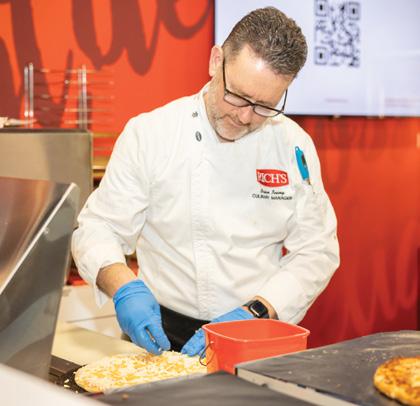
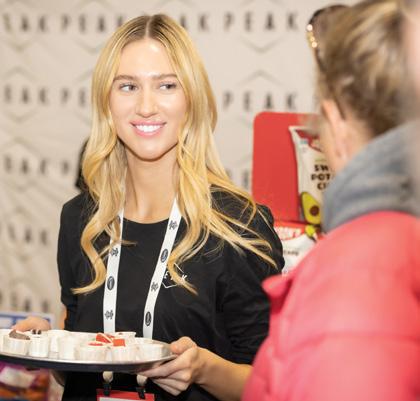

multiple roles for consumers.”
Indeed, the versatility of chocolate is evident in the following trends shaping the category:
When McArthur describes chocolate as a “mood food,” she’s referring to the mental health benefits of indulging in a sweet reward. When it comes to the physical side of things, no one is making chocolate the foundation of a fad diet anytime soon. As Patrick Zeng, marketing director for Mars Wrigley Canada, puts it: “We view candy as a delightful treat, not a dietary staple.”
Still, the nature of chocolate consumption is changing with an eye to betterfor-you choices. First and foremost is the trend towards less: smaller portion sizes and formats that allow consumers to satisfy their chocolate cravings without overdosing on sugar. And according to McArthur, this downsizing comes with an increased emphasis on quality.
“People want better, but less—that’s sort of the trade-off. More of the good stuff, but just in smaller quantities,” she says.
Bernaudo of Longo’s backs up McArthur’s observation. “Portion-controlled offerings are gaining traction as they provide balance, allowing our guests to make healthier choices without compromising on indulgences,” he says.
Even with the understanding that chocolate is inherently sugary and thus not “healthy” in the purest sense, consumers are turning to options such as dark chocolate, which is rich in antioxidants, lower in sugar and fat, and has been associated with improved heart and brain function as well as mood.
“More and more consumers are wanting simple, clean, better-for-you chocolate products,” says Julie Bednarski, founder and CEO of Mississauga, Ont.-based Healthy Crunch, which has a line of Dark Chocolate Superfoods made with cherries, blueberries, golden berries and espresso beans covered in 70% dark chocolate.
Bednarski attributes this shift to a knowledgeable customer base. “Consumers are more educated in terms of what they put into their bodies,” she says. “Better for you just means slightly more protein. Slightly less sugar, not no sugar.”
Greg Burden, director, grocery merchandising for Metro, has noticed similar behaviour in his customers. “Many
consumers are choosing healthier formulations,” Burden says. “Consumers are looking for attributes like lower-sugar, higher-protein or plant-based ingredients.”
Across grocery categories, consumers are opening their palates to new tastes. Factors ranging from changing demographics to social media crazes are driving adventurous eaters to try products featuring flavours from all over the world—and chocolate is no different.
According to Gregoire, Mintel’s July 2025 survey included a question about which chocolate-related innovations respondents were most interested in trying. Topping the list was “internationally inspired” at 24%.
McArthur, meanwhile, sees the current buzz around Dubai chocolate as representative of a broader trend towards Middle Eastern flavours. “I’ve seen some interesting things,” she says. “Dubai chocolate lives with pistachio, but we’re also seeing tahini, and saffron is bubbling up as well—it’s got very distinctive notes.”
At Metro, Burden is also seeing a heightened interest in global inspiration, as well as a general craving for surprising and complex taste profiles. He lists chili, caramel, sea salt and orange dark chocolate as examples.
Though Zeng contends the chocolate category “is rooted in nostalgia and loyalty”—which for Mars Wrigley includes well-established brands such as Mars, Snickers and M&Ms—he also acknowledges changing preferences.
“Consumers do enjoy trying something new, and collaborations or limited-time flavours allow them to experiment while still returning to the classics they know and love,” he explains. “When it comes to flavours, peanut butter has been a standout this year, and we’re also seeing momentum in other nut-based varieties like pistachio and hazelnut.”
For mainstay brands, this opens the doors to innovate with flavours, formats and ingredients. In fact, 69% of people surveyed by Mintel said they were more likely to try a new product from a familiar brand. “It underscores the importance of branding in this space,” says Gregoire. “Brands still have a lot of equity in chocolate.”
As with its bean-based cousin coffee,
chocolate production can be associated with unfair trade practices, exploitation of workers and concerns about environmental impact. And while ethical and sustainable manufacturing isn’t a musthave for every consumer, Canadians care enough about how their chocolate is sourced and made that the subject is influencing category trends.
Nineteen per cent of respondents in the Mintel survey were interested in trying chocolate products that were ethically sourced. “The challenge is, how do you relate it to the value the consumer gets,” says Gregoire. “I think people like the idea, but unless it’s related to the product quality, what does it mean for the consumer?”
For this reason, McArthur believes there is more action and opportunity with premium items than traditional, value-oriented brands.
“On the premium side, where the money’s actually going back into paying the workers more, there’s that direct relationship,” she says. “From bean to bar, people want to know everything that’s being done.”
Metro’s Burden concurs, noting that “certifications like Fair Trade and Rainforest Alliance are gaining traction, reflecting a growing demand for transparency and responsible practices throughout the supply chain.”
Similarly, Bernaudo says this has become a baseline expectation for many Longo’s consumers. “Guests are actively looking for brands that align with their values, with ethical sourcing and sustainable packaging now influencing purchase decisions in a meaningful way.”
Bednarski of Healthy Crunch says ethical and sustainable production is a core component of her company’s mission, along with better-for-you ingredients. “We work with farmers in South America to make sure they’re paid fairly and treated fairly,” she says. “I think a lot of our buyers appreciate that.”
Even category titans such as Mars Wrigley tout the importance of these issues. “At Mars, sustainability isn’t just a goal, it’s a shared responsibility and a core part of how we do business,” says Zeng. “That’s why we’re focused on tackling some of the world’s biggest challenges—from climate action and sustainable sourcing to caring for the communities where we operate.”
Shoppers
are stocking up on natural, multisymptom wellness solutions
that treat—and prevent—seasonal illnesses
By Matt Semansky
of life. And consumers are increasingly looking for treatment options that are naturally sourced. According to research conducted by Ipsos FIVE in July, four of the top five label claims for cough drops and lozenges reflect this demand, led by no artificial flavours/preservatives, with fat-free, no-sugar-added and no artificial colours or dyes also in the mix.
SNIFFLE SEASON IS upon us, and Canadians are arming themselves with a wide range of products designed to deal with coughs, congestion and other cold and flu symptoms. And while the connection between colder weather and respiratory issues isn’t new, consumers have evolved in the way they manage their health.
Product innovation, a desire for value and a more proactive mindset are among the factors leading to changes in consumer behaviour, according to Syed Zeeshan Shams, head of marketing for Haleon Canada, manufacturer of symptom-treatment brands such as Buckley’s, NeoCitran and Centrum multivitamins.
“Canadians are exhibiting behaviour changes following the pandemic. They’re treating coughs and colds sooner and stocking up on medications,” he says.
More than just treating symptoms as they emerge, consumers are doing their best to prevent cold-weather illnesses in the first place. According to Innova Market Insights, global supplement launches with immunity claims have risen by 7% over the past five years, suggesting an increased interest in prevention. And Shams at Haleon cites 2025 Ipsos research indicating 69% of consumers believe early intervention can halt or hinder illnesses, with 71% using a combination of over-the-counter remedies and vitamins or supplements.
No amount of prevention, however, can guarantee protection from cold and flu. With that in mind, here are a few of the trends to expect as consumers go into battle against seasonal sickness:
In an environment of rising prices and belt-tightening, the cold and flu category is like almost every other section in the grocery store. Consumers want their money to go further, so it’s no longer

enough to treat symptoms individually.
“Canadians are seeing cough and cold as an essential shop. It is not considered discretionary spending,” says Shams. “Consumers are turning to multi-symptom or combination products to lessen the number of products purchased.”
With this in mind, Shams says Haleon is working with retail partners to promote a “tool kit” approach to cold and flu treatment. He adds that quick symptom relief is also a key factor in consumer choice. “Instant gratification may be linked to the perception of value.”
Fabio De Rango, pharmacist and associate owner at Shoppers Drug Mart, says convenience continues to be a major factor in shaping customers’ purchase decisions.
“Products that tend to treat multiple symptoms are being favoured over single-ingredient products,” he says. “This is even the case if customers are only experiencing one symptom such as cough; we are finding they want something that will also treat a stuffy and runny nose in case they develop those symptoms later on.”
Cold, cough and flu are natural parts
“This really points to the notion of supporting illness with clean and natural ingredients,” says Jenny Thompson, director of market strategy and understanding at Ipsos.
Among the most popular of these natural ingredients is honey. Over the past two years, Haleon has launched Buckley’s Jack and Jill Honey for children and Buckley’s Soothing Mixture for adults, both of which promise cough and sore throat relief from naturally sourced honey.
At Honibe, honey is the manufacturer’s raison d’être, as all its products feature honey as the primary ingredient. “Consumers are seeking natural, effective and convenient products—and they already know honey is inherently good for you,” says Eins Mutuc, marketing director at Island Abbey Nutritionals, makers of Honibe. “Honey naturally soothes sore throats, calms coughs and supports wellness.”
Mutuc says the company innovates on top of this honey base through natural additives such as vitamin C, zinc, echinacea and elderberry to provide additional immune support.
Once ruled by harsh flavours, syrups and pills, the cold and flu category embodied the phrase “taking your medicine.” But, now, there are more options than ever.
Brad McMullen, president at Summerhill Market, points to the success of Goodvibes Juice Co.’s “shots” —pouched-sized blends such as “Sick Day” made with ginger, cayenne and echinacea tea. “It’s been new to Summerhill the last couple of years and it’s one of our top-selling items,” says McMullen. He also names Beekeepers Naturals, whose product line includes throat-soothing lollipops and immune support sprays.
Mutuc offers a succinct summary of what Canadians are seeking this cold and flu season: “People want multi-symptom relief, enjoyable formats like gummies and lozenges, and full transparency on ingredients and sourcing.”
1 CHEF BOMBAY’S BUTTER CHICKEN MAC & CHEESE
Rooted in South Asian tradition—where pasta or even a sandwich is often elevated by a spoonful of curry, a sprinkle of masala or a dash of chutney—Chef Bombay’s new frozen Butter Chicken Mac & Cheese is packed with flavour and protein (26 grams) and takes less than five minutes to prepare.
2 RAO’S ALFREDO SAUCE
For coating strands of fettuccine or elevating an everyday staple such as macaroni and cheese, this rich and creamy alfredo sauce is made in small batches with carefully selected ingredients—a blend of Parmesan and Romano cheeses, cream and butter—that delivers a smooth texture.

3
3 MONTANA’S READY-TO-EAT SOUPS
Following the recent launch of its ready-to-serve mains, Montana’s restaurant chain is headed to the soup aisle with two hearty options that are ready in minutes. Prepared in Canada, the lineup includes Ribs Style Soup with Vegetables (pork, barbecue-inspired seasoning, carrots, potatoes and corn in a tomato-based broth) and Tex-Mex Style Soup (beans, rice, corn, poblano pepper, tomatoes, red jalapeno and chili spices).
4 FARMHOUSE BY COUNTRY HARVEST
Made with Canadian wheat flour and fermented dough, Farmhouse by Country Harvest is a homestyle sliced bread that is free from artificial preservatives, flavours and colours. It’s available in two varieties: Homestyle White and Honey Whole Wheat.
5 MICHELOB ULTRA ZERO
Labatt Breweries of Canada is expanding its portfolio of non-alcoholic beers— which includes Budweiser Zero and Corona Cero—with the launch of Michelob ULTRA Zero. Marketed as an alcohol-free beer “for an active lifestyle,” it contains only 30 calories per 355-millilitre can.
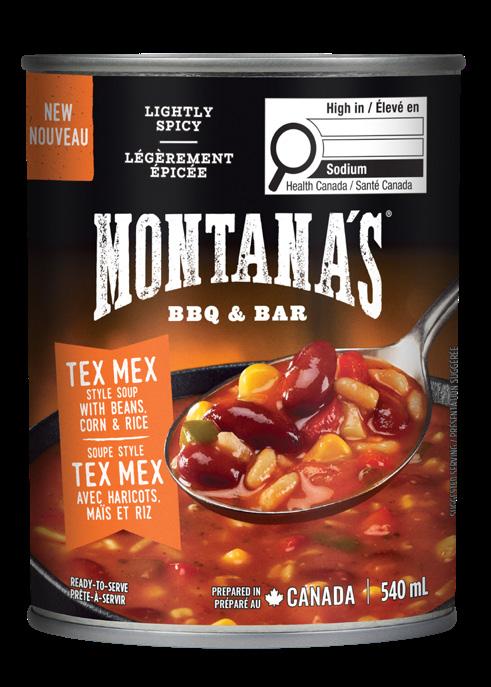
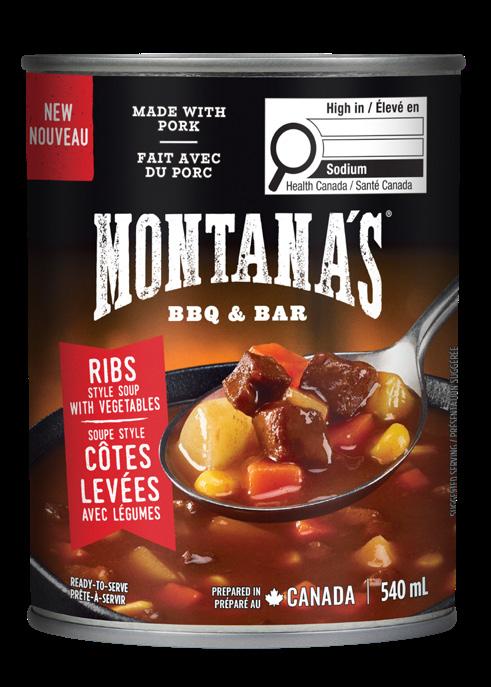
The latest products hitting shelves 1 2 4 5











EnsembleIQ is the premier resource of actionable insights and connections powering business growth throughout the path to purchase. We help retail, technology, consumer goods, healthcare and hospitality professionals make informed decisions and gain a competitive advantage.
EnsembleIQ delivers the most trusted business intelligence from leading industry experts, creative marketing solutions and impactful event experiences that connect best-in-class suppliers and service providers with our vibrant business-building communities.









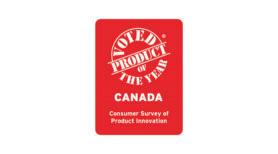








Statista estimates pasta sales in Canada will reach US$1.18 billion in 2025, though growth in recent years has been sluggish. Mauricio Yin Vieira, vicepresident of market strategy and understanding at Ipsos, echoes this, noting that pasta-eating occasions are “somewhat flat.”
But, the market is set for renewed momentum.
Statista forecasts “moderate growth” through 2030, with a compound annual growth rate of 3.26%, driven by “increasing health consciousness and the introduction of innovative pasta varieties”—for instance, more non-wheat options. Demand is especially strong “among gen Z and millennials who are more likely to have dietary restrictions,” says Yin Vieira.
Alternative pasta is “a huge category for us,” says Digs Dorfman, founder and co-owner of Toronto organic and natural food grocer The Sweet Potato. Though corn-, rice- and quinoabased options remain top sellers, driven by gluten-free diets, sales have plateaued in recent years. Now, he says, demand is rising fast for protein-rich options such as black bean and chickpea pastas, which—as legumes—are naturally gluten free, too. “A lot of people are going to gyms and trying to get jacked,” he explains of the desire for higher-protein alternatives. Also trending?
Pastas with unique flavour profiles such as Just Taste Organic Sweet Potato Pasta —a customer favourite, says Dorfman, and a natural fit for The Sweet Potato brand.
By Chris Daniels
At Italian grocer Esselunga, Felicia’s full lineup sits alongside traditional semolina pasta, not in a designated health foods section of the store. It’s a merchandising strategy Stocco believes North American stores should consider. “Felicia is present with more than 10 items,” says Stocco, helping Esselunga “enlarge the category audience” and “improve overall performance.”
The number of pasta varieties— corn, rice, buckwheat, millet, chickpeas, lentils and edamame— continues to grow. But, in a crowded market, some brands are homing in on their most popular options. Switzerland-based Explore Cuisine, sold at Loblaws, Save-On-Foods and Sobeys, is focusing launches on two core varieties. “All new products will be edamame and red lentil,” says CEO Greg Forbes. The brand will continue producing black bean and chickpea SKUs, but sees greater potential in the other two. Red lentil pasta cooks quickly, has a kid-friendly flavour and a nutrition profile parents appreciate. Edamame pasta is packed with plant protein and made from just two ingredients. “We crush edamame beans into [bean] flour, add water—that’s it,” explains Forbes. “No fillers, additives or flavourings.”
At CHFA Now Toronto in September, Explore debuted a red lentil elbow cut—its first elbow pasta—and an edamame and mung bean rigatoni. “It’s the first time we’ve been able to get edamame into a shortcut pasta and took us about five years to develop at our plant in Thailand,” says Forbes. The brand will also relaunch its existing products with new packaging.

In Canada, gluten-free pasta launches increased 13% between 2020 and 2024, according to Innova Market Insights. One key driver has been increased investment from global manufacturers. Italy’s Andriani S.p.A, for instance, introduced its Felicia brand to Canada with varieties such as brown rice noodles, spirulina spaghetti, red lentil penne pasta and buckwheat mezzi
rigatoni. Following a successful launch with Costco Canada last year, Felicia will expand to several other retailers. “We’re not just attempting a one-time brand launch; we’re launching Felicia with a long-term commitment to stay,” says Carlo Stocco, managing director North America for Andriani. “Our goal is to build lasting partnerships and bring meaningful innovation to the market.”
That commitment includes the opening of Andriani’s multi-million dollar, 61,000 sq.-ft. production facility in October in London, Ont. the company’s first in North America. “While the plant will serve all of North America, Canadian customers will have the option to source locally from one of the most recognized manufacturers in this category,” says Stocco. CG
By Kristin Laird
THE GROCERY INDUSTRY is in a state of flux, shaped by rising costs, labour shortages, ongoing supply chain disruptions and shifting consumer habits. To unpack some of this, Canadian Grocer spoke with Michael von Massow, professor in the department of food, agriculture and resource economics at the University of Guelph. He shares insights on why prices remain high, how shoppers are adapting and what to expect when the grocery code of conduct comes into effect. This interview has been edited for clarity and length.
What are the biggest factors driving food inflation in Canada right now?
One of the biggest reasons we’re seeing food price inflation today is that beef prices are going up and that’s pulling substitutes up as well. So, pork prices are going up a little bit. We’re not seeing the same in poultry because they’re supply managed … but beef prices are going up because we had dry weather for a couple of years in Western Canada and in the Midwest of the U.S. When the weather is dry, we can’t produce as much hay or produce as much grass on the pasture. That means we don’t have enough feed for the beef cattle, so we’ve had to shrink our herds to survive. As supply goes down, price goes up—and it takes time to rebuild the herd.
Also, we saw some impacts over the summer from Canada’s retaliatory tariffs. Prices went up on fresh-squeezed orange juice from Florida, sugar and confectionery products. The federal government

picked products carefully to allow consumers to switch to non-tariff products so, … unless you were stuck on an old cheddar from Wisconsin, you could find a less expensive substitute. Now the tariffs are off, we should see some of those prices come down.
How are Canadians adapting shopping habits in response to higher food prices?
We’re seeing some Canadians shift to lower price grocery [banners], and we’re seeing the big grocers respond. Loblaw is closing some of the No Name stores it opened as part of a previous plan, but Windsor [Ont.] was one of the markets affected and Costco has announced plans to build another store there. Some people are changing their stores; they’re going to Food Basics, they’re going to FreshCo and we see that reflected in how grocers are responding. And some people aren’t changing stores, but they’re being more attentive as they buy.
What long-term shifts should grocers anticipate in terms of consumer behaviour, pricing or product mix?
With this significant price pressure and the move to discount, we’re seeing less variety. Suppliers, processors and retailers need to balance a reduced selection, low-budget model with enough variety to meet ongoing demand for specific products. The affordability gap will narrow over time and we will see a return to high-welfare and specialty products and vast amount of choice because there is such diversity amongst consumers.
If you could recommend a policy change that could improve food affordability in Canada, what would it be?
It’s tough to because so many factors affect food affordability. The government can’t undo a drought that changed the beef industry, reverse Trump’s trade policies or end the war in Ukraine. There’s little we can do to reduce costs immediately. The government and grocers get blamed when prices go up probably more than they deserve, and they get credit when prices go down, again, probably more than they deserve. If the government boosted Canadian production, it could improve supply chain consistency, easing price volatility—but it wouldn’t guarantee long-term price reductions.
Canada’s grocery code of conduct comes into effect on Jan. 1. Are there any unintended consequences the industry should be aware of?
Well, it has the potential to increase food prices, right? If grocers can’t extract concessions from their suppliers for things like online infrastructure, pricing, terms or returns—as addressed in the grocery code of conduct—their costs will go up. And when costs go up, prices rarely fall. It’ll be interesting to see the dynamics of the relationship between grocers and their large suppliers. It may mean some grocers will stop listing some low-margin products from suppliers they were extracting concessions from. So, there may be some reduction in variety, but I’m not expecting too much of that sort of thing CG





















2300 Yonge Street, Suite 2900, Toronto, ON M4P 1E4 (877) 687-7321 Fax (888) 889-9522 www.canadiangrocer.com
BRAND
GROUP PUBLISHER/SVP, GROCERY & CONVENIENCE, CANADA Sandra Parente (416) 271-4706 - sparente@ensembleiq.com
PUBLISHER Vanessa Peters vpeters@ensembleiq.com
EDITORIAL
EDITOR-IN-CHIEF Shellee Fitzgerald sfitzgerald@ensembleiq.com
MANAGING EDITOR Kristin Laird klaird@ensembleiq.com
DIGITAL EDITOR Kaitlin Secord ksecord@ensembleiq.com
ADVERTISING SALES & BUSINESS
NATIONAL ACCOUNT MANAGER Karishma Rajani (on leave) (437) 225-1385 - krajani@ensembleiq.com
NATIONAL ACCOUNT MANAGER Julia Sokolova (647) 407-8236 - jsokolova@ensembleiq.com
NATIONAL ACCOUNT MANAGER Roberta Thomson (416) 843-5534 - rthomson@ensembleiq.com
ACCOUNT MANAGER Juan Chacon jchacon@ensembleiq.com
DESIGN/PRODUCTION/MARKETING
CREATIVE DIRECTOR Nancy Peterman npeterman@ensembleiq.com
ART DIRECTOR Jackie Shipley jshipley@ensembleiq.com
SENIOR PRODUCTION DIRECTOR Michael Kimpton mkimpton@ensembleiq.com
MARKETING MANAGER Jakob Wodnicki jwodnicki@ensembleiq.com
EDITORIAL ADVISORY BOARD
RAY HEPWORTH METRO
BRENDA KIRK , PATTISON FOOD GROUP
CHRISTY MCMULLEN , SUMMERHILL MARKET
GIANCARLO TRIMARCHI , VINCE’S MARKET
SUBSCRIPTION SERVICES
Subscriptions: $102.00 per year, 2 year $163.20, Outside Canada $163.20 per year, 2 year $259.20 Single Copy $14.40, Groups $73.20, Outside Canada Single Copy $19.20.
Digital Subscriptions: $60.00 per year, 2 year $95.00
Category Captain: Single Copy $20.00, Outside Canada Single Copy $30.00
Fresh Report: Single Copy $20.00, Outside Canada Single Copy $30.00
Subscription Questions: contactus@canadiangrocer.com
Phone: 1-877-687-7321 between 9 a.m. to 5 p.m. EST weekdays Fax: 1-888-520-3608 Online: canadiangrocer.com/subscription-centre

CORPORATE OFFICERS
CHIEF EXECUTIVE OFFICER Jennifer Litterick
CHIEF FINANCIAL OFFICER Jane Volland
CHIEF OPERATING OFFICER Derek Estey
CHIEF PEOPLE OFFICER Ann Jadown
2300 Yonge Street, Suite 2900, Toronto, ON M4P 1E4. Printed in









We are curators of unique brands, helping to elevate brands in Canada and build customer demand through our appetite for fresh insights and data. Join our tasteful collection, and showcase your products nationwide. Visit treeoflife.ca to learn more.







Beverage is a cornerstone category, continually evolving with the flow of culinary trends. Not surprisingly, water and coffee are the beverage of choice for almost all Canadians with near universal penetration.1 Despite consumers closely managing grocery budgets, they continue to make allowances for natural, healthier beverage options. The #1 beverage claim by Canadians is lower/no sugar, followed closely by “made with real ingredients”.1 Sharing stories about how ingredients are sourced and the people behind them provides an avenue to showcase such attributes and highlight brand authenticity as well as transparency. This consumer demand has produced innovation focused on hydration, a back-to-basics approach of replenished electrolytes as part of overall healthy living. Building on this functional trend, consumers are seeking clean, quality and “real” ingredients that provide additional nutritional benefits. In response to the GLP-1 phenomenon the inclusion of added protein, macro nutrients and functional botanicals will fuel ongoing innovation.
Source: 1. Mintel Canada, August 2024
CANADA: BEVERAGES TYPICALLY CONSUMED, 2024
CANADA: CLAIMS THAT MATTER WHEN CHOOSING NON-ALCOHOLIC BEVERAGES TO DRINK, 2024
Low/no sugar
Made with “real” ingredients
Low calories
Boosts energy
Added vitamins
Supports digestive health
Strengthens immunity
Promotes relaxation
Added calcium
Promotes focus
Piant-based
CANADA: DRINKING BEVERAGES MORE OFTEN, THE SAME OR LESS OFTEN VERSUS LAST YEAR, 2024
Our passion for exceptional Cheese & Deli is at the heart of everything we do. With a discerning eye for quality and a deep love for the craft, we curate the world’s finest offerings to inspire elevated food experiences. As dedicated category specialists, we don’t just follow trends - we help shape them.







Underscoring its central role in Canadian diets, not only is Cheese consumed by 94% of households but the category continues to show strong growth year over year.1 In total, the category represents $3.7bn, with Exact Weight cheese representing a 94% share.2 Exact Weight, also known as Prepack, is growing +4% in dollars and +2% in volume.2 At least 2/3 of consumers have eaten at least three types of different cheese in the last three months, confirming that at-home deli drawers hold multiple varieties – and consumers are willing to add additional staples to their rotation.1
Specialty Cheese is the largest segment, representing 1/3 of the category. Specialty Cheese is continuing to show robust growth of +9% in dollars and volume – an indicator that, despite consumers watching grocery prices, there is still significant demand for this segment.2 The top specialty cheese types are Feta, Cheddar and Paneer – a clear reflection of Canada’s evolving demographic.
Sources: 1. Mintel Canada, May 2025
2. Nielsen, Exact Weight + Random Weight, NATIONAL EX NFLD GB +DR +MM L52W period ending July 26, 2025
CANADA: TYPES OF CHEESE EATEN IN THE PAST THREE MONTHS, 2025
Cheddar
Mozarrella
Parmesan
Swiss Feta
Gouda
Brie/Camembert
Provolone
Blue cheese
Goat
Paneer
None of these
Source: Mintel, May 2025
% of consumers
EXACT WEIGHT - TOP 8 SPECIALTY SEGMENTS IN THE PAST THREE MONTHS, 2025
% of consumers
CANADA: REPERTOIRE ANALYSIS OF TYPES OF CHEESE EATEN IN THE PAST THREE MONTHS, 2025

1-2 types of cheese
2025
3-4 types of cheese 5 or more types of cheese




Source: Nielsen, Exact Weight, NATIONAL EX















Overall, the growth of Flavoured Coffee Creamers in Canada is propelled by consumer demand for variety, innovation, plant-based and functional options, and the ability to customize the coffee experience, all amplified by urban lifestyles and social media trends.1

Flavoured Coffee Creamers category growth of +8.4% $ sales ranks among the highest growth categories within Refrigerated Dairy, as the total Refrigerated Dairy department posts +4.9% $ growth in the Latest 52 weeks.2 Canadians are highly receptive to new coffee experiences, with a strong interest in flavoured creamers and unique flavour profiles. This openness is particularly pronounced among younger generations, who are more likely to experiment with new products and seek out creative coffee options, including flavoured and plant-based creamers.3
Refrigerated Coffee Creamers which hold a 90.4 $ shr of total creamers, are posting strong growth of +5.7% $ sales, with both Traditional +5.9% $ and Plant Based +5.1% $ sales. Non-refrigerated Coffee Creamers (9.1 $ share) are also finding success in the latest 52 weeks with +27.3% $ growth led by Barista Shelf Stable Creamers, posting gains of +25.2% in the last 52 weeks on increased Total Distrinbution Points (TDP’s) of +25.5% and increasing $ Sales per Point of Distribution (SPPDP) of + 21.9%.2
There is a notable demand for plant-based creamers, especially in provinces like Ontario and British Columbia, where consumers are more likely to prefer dairy alternatives. This trend is influenced by demographic factors, such as a higher population of individuals of Chinese background, who show a strong preference for plant-based options. Newer Canadians, in general, are more interested in plant-based and protein-enriched creamers compared to established Canadians.3
Sources: 1 Mintel, Identifying New Opportunities for Coffee Creamers – 2025
2 Nielsen MarketTrack, National Inc NFLD GB +DR +MM, L52W period ending August 9th, 2025
3 Mintel, Coffee & Coffee Shops – Canada – 2025
L52W ENDING 6/9/25
L52W ENDING 6/09/24 # OF BUYERS # OF OCCASIONS VALUE PER OCCASION






Source: NielsenIQ Panel On Demand Homescan I CA - DANONRE - COFFEE CREAMERS | 11 Facts of COFFEE CREAMERSFLAVOURED for Total Outlets in Total Canada during L52W period ending June 9, 2025










The Canadian Chocolate market is well-established and a steadily growing industry, that saw +2% growth in $ sales in 20241. With Chocolate so synonymous during the holidays, key seasonal peaks, such as Valentine’s Day, Easter, Halloween, and Christmas contribute significantly to overall sales of the Chocolate market2. During these times, the Chocolate industry is often greeted with seasonally-specific graphics, limited-time formats, or limited-time offerings during key holidays. Nearly two-thirds of Canadian households purchase Chocolate during the Christmas holiday3, making Christmas the largest $ sales driver of category sales during the year. Chocolate remains a popular Christmas gift, with 1 in 2 people choosing to give it during the holiday season4. Boxed Chocolate represents 62% of total seasonal category $ sales5, making it the most loved form of Chocolate during the holidays. In particular, Boxed Chocolate is a favourite for gift-giving, for hosting or for sharing during a party, or even as a self-indulgent treat during the festive season6 .
As a retailer, stocking up on leading-brand Boxed Chocolates will provide your shoppers with options for all their holiday special moments.
Sources: 1. NielsenIQ Discover, Total Chocolate, National GDM+ RFC + C&G + GMWC, L52W period ending December 28 2024
2. NielsenIQ Discover (XMAS INCL (EVDAY SEAS EXCL JR), National GDM + RFC+ C&G, 9 week period ending December 28 2024; EASTER SEAS CHOC, 12 week period ending April 6 2024, NATIONAL EX NFLD GB + DR + MM + RFC + C&G; VAL INCL (EVDAY SEAS), 5 week period ending February 24 2024, NATIONAL EX NFLD GB+ DR + MM + RFC + C&G; HLWN SEAS + EVDAY SEAS JR, 13 week period ending November 9 2024, NATIONAL EX NFLD GB+DR+MM + RFC + C&G)
3. Numerator Insights, Christmas Chocolate, Total Outlets, 9 week period ending December 28 2024
4. Suzy 2023– Christmas Survey n=300, Shoppers 18-65 who bought Chocolate at the Holidays
5. NielsenIQ Discover, XMAS INCL (EVDAY SEAS EXCL JR) BOXED Chocolate, National GDM + RFC + C&G, 9 week period ending December 28 2024
6. Suzy – Christmas Survey n=300, Shoppers 18-65 who bought Chocolate at the Holidays
CHRISTMAS IS THE BIGGEST SEASON OF THE YEAR FOR CHOCOLATE
BOXED IS THE BIGGEST FORMAT AT CHRISTMAS WITH SHOPPERS BUYING FOR GIFTING, HOSTING AND TREAT OCCASIONS
Total Christmas $ Sales: $302.5M




Source: NielsenIQ Discover XMAS INCL (EVDAY SEAS EXCL JR), 9 week period ending December 28, 2024. NATIONAL EX NFLD GB + DR + MM + RFC + C&G EASTER SEAS CHOC, 12 week period ending April 6 2024, NATIONAL EX NFLD GB + DR + MM + RFC + C&G VAL INCL (EVDAY SEAS), 5 week period ending February 24 2024, NATIONAL EX NFLD GB + DR + MM + RFC + C&G HLWN SEAS + EVDAY SEAS JR, 13 week period ending November 9 2024, NATIONAL EX NFLD GB + DR + MM + RFC + C&G
CHOCOLATE CONTINUES TO BE A KEY GIFT AT CHRISTMAS
Christmas 2024 Halloween 2024 Valentine’s Day 2024 Easter 2024 gift Chocolate every year gift because everyone likes it people gift it on its own
Source: Suzy 2023 – Christmas Survey n=300, Shoppers 18-65 who bought Chocolate at the Holidays
Q14 - Do you always give chocolate as a gift at the holidays?
Q15 - Why did you decide to purchase Chocolate as a gift this year?
Q13 - When gifting chocolate this Holiday Season, did you gift the chocolate with another item or just gift on its own?
Source: Nielsen Market Track. XMAS INCL (EVDAY SEAS EXCL JR). 9 week period ending December 28 2024. NATIONAL EX NFLD GB + DR + MM + RFC + C&G
TOP REASONS WHY SHOPPERS BUY BOXED CHOCOLATE AT THE HOLIDAYS
Source: Suzy – Christmas Survey n=300, Shoppers 18-65 who bought Chocolate at the Holidays
Q4 – And now, for each of the reasons you just mentioned, please select the chocolate format/s you purchased for each of those occasions
In 2024, we installed solar panels on our grading stations and farms in Southern Ontario.


Taking local action for the greater good.™
Winner, Canadian Grocer Impact Award Sustainability Category (2024) *At the Gray Ridge
We harness enough power to sustain approximately 65 average households every day, reducing our energy consumption up to 26%* © Gray Ridge Eggs, Inc., 2025






The Canadian egg market including shelled, hard-boiled, liquid, and liquid replacement products represents a $1.6 billion category in Canada.¹ Although shelled egg growth is the largest driver of egg performance, all forms of eggs such as hard-boiled and liquid eggs both grew +8% in dollars vs YA. (Figure 1)
Shelled eggs has a wide consumer appeal as evidenced by over 92% of Canadian households purchasing a shelled egg product. 2 Despite being a mature sector, which typically experiences limited expansion, the category has shown significant growth of +$139MM or +9.5% vs last year. This trend is driven by shoppers increasing their amount spent on eggs by an average of 6.6% on each shopping trip. (Figure 2)
It’s not just revenue that’s growing in the category. Canadian consumption of eggs has increased as tonnage (dozens) is up by 4%. Consumers are clearly moving to larger sizes as both 24 packs and 30 packs have grown tonnage by 37% and 33% respectively. Contrast that by declines in 6’s and 12’s at -15% and -5%. (Figure 3)
Another consistent trend in the category is the growth of specialty eggs. Conventional eggs have grown tonnage by +3% where specialty eggs grew +6% driven by all segments. (Free run +20%, Free range +9%, Omega +8%, Organic 12%) ¹
Unlike most categories, local / provincial brands are important and represent a sizable share of category dollars. Local / Regional egg brands represent a 29.9 dollar share of the shelled eggs category and are growing +9.9% vs nationally branded eggs which represent 12.1 share of dollars and growing at 2.6%. (Figure 4)














Despite ongoing economic pressures and changing routines, Canada’s frozen food category continues to show remarkable resilience. In the latest 52 weeks, total tracked frozen food sales surpassed $8.8 billion, with per capita consumption climbing to 32 units per person per year.1
Frozen dinners and entrées, the category’s largest segment, has surged with a 7.7% dollar CAGR, now reaching $2.7 billion in sales. In the latest 52 weeks sales rose +2.3% reflecting strong consumer demand for convenient, high-quality meals.1
A major driver is the shift in where meals are sourced. Retail accounts for over 84% of eating occasions, similar levels seen during the pandemic in 2020.2 While a 1% increase from 2023 may seem minor, it reflects a meaningful return to at-home dining. Frozen foods are well-positioned to meet this shift, offering value, convenience, and versatility—consistently cited as top purchase drivers.3
With overall frozen food sales and units rising, families with kids (43% of frozen occasions), multicultural households (27%), and younger generations (49%) remain key contributors to category strength, together accounting for a major share of frozen food occasions.3
Innovation is also driving excitement, with globally inspired meals and better-for-you options expanding the aisles. In fact, 24% of food occasions are motivated by a desire for healthy or nutritious choices.2 Both Gen Z and Millennials tend to opt for more multiculturally-inspired dishes, underlining the appetite for exploratory taste preferences and cuisines.2
As Canadians continue to balance busy schedules and evolving tastes, frozen foods are set to remain a trusted staple in households from coast to coast
Easy to prepare/little or no planning
Satisfies my hunger
Wanted something tasty
Comforting
Good value for the money
Satisfies a craving
Could be eaten quickly
Wanted something all the household members ...
Good to share with friends/family
Could be made with items on-hand
Source: Mintel, May 2025












The Canadian peanut butter category is valued at $347.6 million,1 holding steady in dollar sales with a modest -0.3% decline in pounds sold in 2025. Conventional peanut butter (excluding Natural) continues to anchor the segment with 78.3% share,1 though it faces gradual year-overyear dollar volume declines. Natural peanut butter remains a category growth driver, posting +3.3% in dollar sales and increasing share to 21.7%.1
Peanut butter’s role as a staple in Canadian diets is underscored by strong penetration at 66.5% of households,2 with equally robust repeat rates, with 71.4% of buyers returning, highlighting habitual consumption and loyalty across the category.2 According to NIQ’s Category Shopping Fundamentals survey, consumers are increasingly guided by health-oriented attributes, particularly: natural ingredient profiles, reduced or no sugar content, and the absence of artificial additives. These preferences are likely contributing to the sustained momentum in the Natural segment, signaling a gradual shift in consumer expectations toward cleaner labels and perceived better-for-you options.
Sources: 1. NielsenIQ, NAT GB+DR+MM, L52W period ending May 18, 2025 2. NielsenIQ Retail


Your cereal’s zero sugar sidekick.














Nutritional quality of plant-based beverages is increasingly important, with consumers seeking products that offer added vitamins, minerals, and protein. Shoppers are motivated by the quality and presence of added nutrients and clean ingredient labels, and there is a growing expectation that plant-based drinks should match or exceed the nutritional benefits of dairy milk.1
Products that highlight high or added protein are especially appealing, as seen with launches that mix plant-based ingredients to boost protein levels and the continued leadership of soy as a plant-based protein.1 Soy, a high-protein plant-based food, considered a complete protein containing all nine essential amino acids, is leading the category with +1.9% $ sales growth in the latest 52 weeks. Plant-based offers reduced sugar and calories compared to dairy-milk, with reduced sugar being a commonly sought after attribute in new product launches.3
Price continues to be a driving consideration—both as a motivator for purchase when it decreases and as a barrier when non-dairy options are perceived as too expensive.2
Sources: 1 Mintel, Dairy & Non-Dairy Milk - Canada – 2023
2 Mintel, Dairy & Non-Dairy Milk - Canada – 2023
3 Mintel, Milk and Non-Dairy Milk US Databook – 2023





$6,128,057 Dairy-Like $3,261,056

























other $1,972,862 Rice $149,361,432









The Mayonnaise and Sandwich Spreads category represents a $423.5MM market, currently growing, with dollar sales up 4.5%, and sales pounds up 2.1%.1
Mayonnaise remains the dominant segment with 83.0% of category share and has gained share each of the past two years. Much of the Mayonnaise category’s growth has been driven by the increasing importance of flavoured items (+74.7% sales pounds vs. 2023).1
Penetration of Mayonnaise is 69.1% and has seen consistent year-over-year growth in household reach.2 While inflation has contributed to Mayonnaise’s growth, the category’s slight increase in pounds per buyer indicates potentially stronger consumer engagement. Additionally, the repeat purchase rate has risen to 73.4%, reflecting improved loyalty and sustained demand.2
Sources: 1. NielsenIQ Retail Measurement | CA - KRAFT HEINZ - VISCOUS - 5 Facts of 7 Products in NATIONAL EX NFLD GDM + GM+WC during 3 52 Weeks Rolling, 2 Years, YTD period ending July 26, 2025; 2. 13 Facts of VISCOUS, MAYO (MAYONNAISE), SSD (SPOONABLE SALAD
34 weeks ending August 23, 2025 Demographic













$ AND $ CHANGES VS. YA $ SHARE PER

(in $ millions) (in millions of sales pounds)





Source: NielsenIQ Retail Measurement | CA - KRAFT HEINZ - VISCOUS - 5 Facts of 7 Products in NATIONAL EX NFLD GDM + GM+WC during 3 52 Weeks Rolling, 2 Years, YTD period ending July 26, 2025.








Yogurt has seen another breakout year in Canada fueled by increasing household penetration, hitting 88.9% in the latest 52 weeks +0.4 pts1 and growing consumer demand. The category has experienced a noticeable shift to premium segments providing value-added and functional benefits. The category is among the fastest growing within Refrigerated Dairy in the latest 52 weeks at +11.5% $’s and +6.0% EQ (equivalized tonnage).1
The primary motivation for increasing yogurt consumption among Canadians is the pursuit of a healthier diet. Consumers are seeking yogurts with specific health benefits, such as high protein, digestive health, and immune-boosting properties. Functional benefits and natural ingredients, including real fruit and locally sourced dairy, are especially appealing to health-conscious Canadians.2
Half of Canadian yogurt consumers are willing to pay more for yogurt that offers added health or functional benefits, such as high protein content.2 Younger consumers are driving this willingness to pay for extra benefits including functional health. Nearly half (45%) of Canadian yogurt consumers consider “high in protein” an important health-related factor when choosing yogurt or yogurt drinks. This demand is part of a broader trend where protein is prioritized for its role in supporting muscle health, satiety, weight management, and overall balanced diets.2 The two largest segments within the Yogurt category benefit from these trends with High Protein Yogurt hitting a 39.9 $ share, on +27.4% $ growth and Gut Health holding the #2 spot at 19.2 $ share with +1.8% $ growth.1





